Tajinder Kumar’s RAAF journey

Level 24/44 Market St, Sydney 2000 • GPO Box 108, Sydney 2001 • Ph: 18000 15 8 47 Celebrating 25 years and 22 Multicultural Media Awards
LINKING INDIA WITH AUSTRALIA
SYDNEY
NEW HORIZONS
FREE SEPTEMBER 2020 n indianlink.com.au MELBOURNE




2 SEPTEMBER 2020 www.indianlink.com.au
PUBLISHER












Pawan Luthra




EDITOR






























Rajni Anand Luthra





SOCIAL

Trump-Biden woo Indian-American voters
BY PAWAN LUTHRA

Of the 1.8 million Indian Americans eligible voters, it is estimated that 1.3 million live in the eight key states which could decide the next President of the United States.

Sizeable Indian American voters live in four of the eight key states, these being Michigan (125,000), Pennsylvania (156,000), Florida (193,000) and Wisconsin (37,000). These states formed the blue wall that crumbled in 2016: Democrat hopeful Hillary Clinton lost them by a combined total of fewer than 80,000 votes which was 0.06% of the 137 million votes cast. Donald Trump went on to become US President.

This time round, Republicans and Democrats are both working overtime to woo the Indian voters. Both however, come with their own baggage.
On the one hand, President Trump is portraying himself as the true friend of India, with ads aimed at the Indian community showcasing his close relationship with Indian PM Modi. The
two mammoth rallies of Howdy Modi and Namaste Trump feature prominently in his courtship of the community. A widely publicised naturalisation ceremony including a sari-clad woman also purported to cement his credentials within America’s Indian community. Trump may also have chosen deliberately to keep very quiet on India’s domestic issues.
And yet Indian Americans must surely be uncomfortable with Trump’s growing white nationalist base. His open attacks on foreigners taking away American jobs, curbs on H-1B visas and overall restrictions on immigration, have not gone down well with the Indian community.
On the other hand, the Democrats also come with their plusses and minuses.

Joe Biden’s choice ofpart-Indian Kamala Harris has curried favour with the Indian community (and in all probability caused the Trump camp to ramp up the India message in their marketing.) Harris often talks about how her views were shaped by her grandfather in Chennai in her childhood. The Democrats are at pain to point out the two visits by Barack Obama to India, including one as the chief guest for the Republic Day parade and also of his support for India to secure
a permanent seat at the UN Security Council. Biden’s support for an Indo-US civil nuclear deal is also counted in his favour.
Over the past year however, the Democrats have taken India to task on Modi’s Kashmir policy and the Hindutva agenda. Many Indian Americans were also incensed by Biden when in an attempt to woo the Muslim American voters, he also criticised India’s Citizenship Amendment Act and the National Register of Citizens.


With all this in the mix, the Indian American vote bank lies split along identity lines. There are those who favour the strong rise of Hinduism in India and what it offers, yet progressive IndianAmerican activists have long criticised the Hindu nationalist discourse for its caste bias.
The challenge for both major parties will be to strike the balance between what they have said and done, and what they promise to do, should they come into power. And as for the Indian American voters, well, they’d better get used to getting special treatment – pundits are calling the 2024 US Presidential race to be between Republican Nikki Haley and Democrat Kamala Harris.

That could be an interesting one.






SEPTEMBER 2020 3 NATIONAL EDITION EDITORIAL
MEDIA Suruchi Sehgal MELBOURNE COORDINATOR Preeti Jabbal CONTRIBUTORS Rhea L Nath, Bageshri Savyasachi, Manan Luthra, Mohan Dhall, Ekaagra Kesarwani, Emie Roy, Sandip Hor, Minal Khona, LP Ayer SALES Charuta Joshi Indian Link is a monthly newspaper published in English. No material, including advertisements designed by Indian Link, may be reproduced in part or in whole without the written consent of the editor. Opinions carried in Indian Link are those of the writers and not necessarily endorsed by Indian Link. All correspondence should be addressed to: IND IAN L IN K M ED IA GR O UP Level 24/44 Market St, Sydney 2000 GP O Box 108, Sydney 2001 P h: 02 9279-2004 Fax: 02 9279-2005 Email: info@indianlink.com.au
Engineering.
Maria’s pathway to
11771_WSU_TheCollege_PressAd_HP_English_Maria_170mmHx250mmW_ARA_OL_5mmBleed.indd 1 10/12/19 4:08 pm
Where ambition makes a degree
possible.

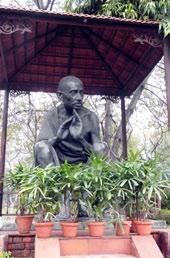







4 SEPTEMBER 2020 www.indianlink.com.au Tajinder Kumar’s RAAF journey 08 cO ve R STOR y 30 32 15 23 SP ec IAL feATUR eS 15 YOUTH Subtle Curry Traits 22 OPINION Hope and reassurance, not angst and division 23 STUDENTS Why I chose Hindi in Year 12 30 TRAVEL Gandhi’s Delhi 32 FOOD Oatmilk for nutrition as well as sustainability c ONT e NTS For testing clinics and the latest information visit nsw.gov.au More cases in NSW. Stay alert. It’s up to everyone to stay alert and help stop the spread of COVID-19. > Get tested at the first sign of a symptom, and self-isolate. > Stay 1.5m apart from others when outside your home. > Wash hands often. > Wear a mask when you can’t keep your distance. Find out if you have visited a location associated with a confirmed COVID-19 case at nsw.gov.au. You may have to get tested and self-isolate immediately for 14 days, or monitor for symptoms.
Dr Madeleine Fitzpatrick
>>>> COVID ALERT >>>> COVID ALERT >>>> COVID ALERT >>>> COVID ALERT >>>>
Iluka 4.1 with Oaklands Facade

Starting from $289,000*
*Sydney based pricing

A modern Sydney home is epitomised by an inviting open plan living and dining area that flows into an alfresco space.


The Iluka 4.1 is one of our popular designs, the floor plan boasts a large kitchen close to the dining area, 4 bedrooms making this the perfect home for a big or growing family, with each room enjoying built-in wardrobes The master bedroom offers a walk-in wardrobe and an ensuite bathroom. To bring the family together and there is a home theatre just off the living room, but separate from the open living spaces.
If you also build a single storey home with New Living Homes you can pick $35,000* worth of upgrades that you want for free! Scan




SEPTEMBER 2020 5 NATIONAL EDITION
the QR code
more information or visit newlivinghomes.com.au | call 1300
Display home locations open 10am - 5pm, 7 days a week *Conditions: Images may depict landscaping & decorator items which are not supplied by New Living Homes & are not included in the price. Site costs may vary according to site classification, survey & site inspection, site conditions including rock and fill subject to building setback. Separate legal contracts may apply to the “Home and Land” components. New Living Homes is only responsible for the contract relating to the construction of the building. Prices subject to registered land. Prices subject to Statutory Consenting Authority approval and specified conditions, bushfire requirements and acoustic report. Inclusions based on New Living Homes Inclusions unless otherwise specified. New Living Homes reserves the right to revise plans, specifications and pricing without notice. Please contact a Sales Consultant for more information. All plans are subject to copyright protection. New Living Homes Pty Ltd - BLIC 244889 ABN 67152611713 Including standard site costs and BASIX
for
366 766
YOUR SAY
HARRIS PARK BRAWL
Readers condemned a recent brawl that took place on the streets of Harris Park NSW, an incident into which police investigation is currently ongoing.
Sareeta Nand-Singh wrote: All because of an argument on Tiktok? Was it even worth it?
Rajbir Singh Randhawa wrote: The sad part is, only people from one community got arrested. The people who ashed bats and rods are still free and posting videos on Tiktok with pride.
Francis Augustine wrote: This is not India; obey the law of the country or you will be punished.
Alan J Maurice wrote: Ten years sounds harsh.
Jaswinder Singh Boparai wrote: They did wrong and should be punished for it. But 10 years? Brawls happen almost every weekend in city nightclubs, do they get 10 years?
Syed Mohammed wrote: For everybody else, we are all just Indians here.
Raita phailaana hai to wapas India jaao aur waha karo jo karna hai. If you want to protest, get police permission beforehand.
Mahendar Singh wrote: Those involved should be deported. We don't want this lth here. Australia is over-tolerant. Weed them out.
Renu Dutta wrote: (The matter) should have been taken to the police for inciting hatred in the community rather than rioting on the streets.
PODCAST
BAGESHRI SAVYASACHI’s regular presentations touch upon a variety of issues that affect us all as Indians, as Australians and as citizens of the world.

Ep 4: Why New Australians must learn more about Aboriginal culture
Indu Balachandran
wrote: As India’s 73rd year of independence from British rule was celebrated over the weekend, Indian immigrants take the opportunity to re ect on our interaction with the Australia of First Nations Peoples. Thanks to Bageshri Savyasachi for a thoughtful interview
Roanna Gonsalves wrote: Such insightful words from Indu Balachandran in this podcast. It was privilege to be featured alongside Indu, speaking with Bageshri Savyasachi about Indian immigrants and awareness of Indigenous communities. Thank you Indian Link for continuing this important conversation.
Ep 5: Oz fails media diversity test again
Aneeta Menon wrote: Thanks Bageshri and Indian Link for this. Time is well and truly up for excuses about why #ausmedia is so white. We need to acknowledge the unwillingness to diversify, because it certainly isn't an inability.
Geoff Mark Field wrote: Hopefully we here at 2SER can help change the situation.

SAY IT AGAIN
Is the social bubble a straight one for one swap? Can person X be in the social bubble of person Y, but person Y be in person Z’s social bubble? Does this even matter? I miss the pub?
Osman Faruqi, Australian journalist
SSR ON BILLBOARDS
RHEA L NATH reported on the seven billboards that went up in Melbourne recently calling for justice in the Sushant case.
Chenoa Sharni Fernandez wrote: Unfortunately we are in a lockdown and cannot go beyond 5km radius from where we live. None of these billboards are in my area. I would love to be able to drive around to see them all.
Sunita Jeet wrote: Delighted to see so many people are supporting SSR for justice! RIP, beautiful soul.
Dhiraj Arora wrote: Wow, just fabulous to see support coming out of Melbourne. Virat Singh wrote: Who is paying for these hoardings? This is political now. Margaret Ratnam wrote: Following the case from Australia. How much longer will the grilling of these culprits take?

Barinder Aujla wrote: Politically motivated move. A lot of poor people dying on the streets every day, but you guys want fair probe on this matter alone?
Kewal Shah wrote: I reckon need for the moment is to help Indian students and people who have lost their jobs / livelihood due to COVID, especially in Victoria, rather than spending on hoardings.
Chitra Iyer wrote: What do the billboards achieve? I think (the issue) is best left in India. I can’t believe a newspaper like Indian Link gets involved in this!
Vandana Suri Mehra wrote: Indian Link is always trying its best for people living miles away to be connected with their roots - be it miracles, wonders, politics, entertainment, pain or pleasure!
Varun Rao wrote: Everyone is entitled to their opinion. There is no harm in getting associated with a matter which is concerning so many Indians (whether inside or outside India). Indian Link is doing a good job in reporting these stories. We can do what we want upon reading these stories.
Ranjeeni Devendra wrote: Indian Link as a newspaper serves as a link between the Indian community and India as such this article is very appropriate.

ADELAIDE TODDLER RETURNS
MITAL PAREKH reported on the heartwarming story of Prisha Patel, stranded in India for a year and nally reunited with her family thanks to the help of complete strangers Neha Soni and Shailesh Thorat.

John Rambo wrote: Great one Shailesh. Kindness and helping people in distress speaks volume of your commitment towards humanity. You are a good man.
Shekhar Palande wrote: Well done Shailesh! It was very nice of you.



Danishi Bhargava wrote: Commendable act of kindness, Shailesh Thorat.
Not going to reproduce THAT cartoon from our esteemed national broadsheet, but let’s reclaim #littlebrowngirls please. The ones I know are feisty and smart, and won’t play second ddle to ageing pollies or racist cartoonists. Sukhmani Khorana, academic
I don’t really understand social media. On my Facebook page, someone posted something nasty replying to a post I made. I replied in a sarcastic manner, pointing out spelling mistakes etc. He “liked” it. What am I doing wrong?
Colin Mochrie, stand-up comedian
6 SEPTEMBER 2020 www.indianlink.com.au
INDIA A TO Z

In our Independence Day special edition, we asked readers young and old to go through the alphabet and nd, for each letter, an iconic facet of Indian life that resonates with them.
Krish Na wrote: Good one. Some alternative suggestions: B for Bollywood - India’s biggest cultural export. Q for Qawwali was a good one, but India claiming Nusrat is probably ‘cultural appropriation’. Altaf Raja is a better t. Us pardesis connect to him better.
Manan Sehgal wrote: Krish Na, couldn’t think of anything else except Bollywood. However, interesting choices in the list.
Sam Naidu wrote: B for Bollywood!

Harshad Pandharipande wrote: I enjoyed reading this. A great idea, executed brilliantly.

Neeta Chaman wrote: Loved A for Amul, G for Ganga, I for India Gate, J for Jugad, L for Lehanga, M for Mango, U for Unity, and the young ones who wrote X for Xerox and Z for Zameen just blew me away.
Amit Goel wrote: These days in India, M is for Modi Modi Modi.
SPOT YOUR FAVOURITE CHARACTER FROM INDIAN TV
There are 58 characters from memorable Indian TV shows in this image. How many can you spot?

Agasteena Shah-Patel wrote: Vikram Vetal, Jaspal Bhatti, Wagle Ki Duniya, Antakshari, Sanjeev Kapoor Khana Khazana, AB from Karodpati, Bapuji from Tarak Mehta, Ashok Kumar, Karam Chand, Mungerilal, Hum Paanch, Chanakya, Yeh Jo Hai Zindagi, Jassi Jaisi Koi Nahi, Koffee with Karan, The Kapil Sharma Show, Byomkesh Bakshi.
Natasha Saluja wrote: Babajee Ka Baiscope, KBC, Ulta Pulta, Shaktiman, Aladin, Chankya, Bhabhijee, Hum Log, Bahrat EkKhoj, Sarabhai vs Sarabhai, Crime Patrol, Shreeman Shreemati, Malgudi Days, Jodha Akbar. Sheetal Bhagat wrote: Super Dancer, Indian Idol, Khatro Ke Khiladi, Meri Awaz Hi Pehchan Hai, Mahabharat, Radha Krishna, Razia Sultan,Bhabhiji Ghar Par Hain, Major Raghav.

Sa re ga ma pa, Banu Main Teri Dulhan, Aap Ki Adalat, Nagin
Bidhai, Ghar Ki Lakshmi Betiyan, Star Voice of India, Rising Star, Chitrahaar, Dilhai Hindustani Sa Re Ga Ma Pa L'il
Anmol Bhardwaj wrote: Shaktimaan! On the terrace!
Shikha Jain wrote: Bigg Boss, Of ce Of ce, CID, Kichdi, Chacha Chaudhary, Pavithra Rishta.



WHERE IN INDIA
This is not a forest. It is ONE GIANT TREE. We asked you to identify this strange specimen of plant life, now a tourist attraction.

INDEPENDENCE DAY PHOTO CONTEST #MYINDIANLINK


We asked you to send us your best image that screams India! Sachin Wakhare’s entry – from a recent boys’ trip to Leh – won the top prize. The region was in the news only recently for a border skirmish with China.
Sachin Wakhare wrote: Thank you Indian Link ... Jai Hind.
Preeti Jabbal wrote: It’s a great photo - aesthetic, patriotic, creative.
Chirag Patel wrote: Epic picture, and extremely proud to be part of it.
Thanks bhai, for taking the effort
Ronak Patel wrote: Amazing. Thanks for entering the competition, glad to be part of this iconic pic and holding the ag!
Swati Alok Tiwari wrote: A picture that leaves an indelible impression in our hearts! Truly inspiring.

Amruta Onsker wrote: Congratulations! A wonderful shot.


INDIAN LINK POLL




Formals and graduation ceremonies allowed for Year 12 students in NSW. Do you think this is a good idea?
YES. Absolutely. There's no harm. 58%
NO. Better safe than sorry. 42%
Was on TikTok for an hour & felt like an adult pretending to be a teenager to hang out with teenagers. DELETED.


Hari Kondabolu, stand-up comedian
Had my baby’s four-month check-up today and one of the questions is “and how does your baby interact with others”? Hilarious. How am I meant to know – he hasn’t seen anyone but his parents almost his whole life!
Myriam Robin, Australian writer
Readers Raj Saneja, Meghna Mehta Mody and Agasteena Shah-Patel got it right. This is a banyan tree (Ficus benghalensis) located in Kolkata, India, at the Acharya Jagadish Chandra Bose Indian Botanic Garden. Believed to be at least 250 years old, the tree continues to grow to this day.
I really blame our education system for making Social Studies as boring as it is considering it’s literally the only subject we actually use as adults.
Sonia Mariam Thomas, Indian journalist

Wearing a mask with sunglasses gives me a level of anonymity I've desired.
@tweetlikeriri, Twitter user

My neighbours are playing “Get Up Stand Up” by Bob Marley and playing basketball in their driveway. If they are protesting restrictions, then I like their methods more than others.
Tarang
Chawla,

writer and Mental Health Advocate

SEPTEMBER 2020 7 NATIONAL EDITION
COVER STORY Abdul Kalam. The missile propelled India into the elite space club. The man refused to hate the people’s vision of technological India and inspired many to embrace of the nation. Among the present my tribute to the great man. While Kalam's unending list of scientific achievements and embrace his innocent smile which, even after his VARGHESE (Adelaide) Having been born in Delhi, mistakes made as child India, India Gate. now, always wondered why confused the two symbolic Was the memories of those Or watching the Republic Day celebrations with pride. bounded by family-centered sentiments. distinctly and watching other families also enjoying themselves. (Canberra) This one iconic word is what believe in design or planning: when push comes to shove, we somehow manage to get things done. You ask how? Some may call derogatory term for improvising, but jugaad-a-bility We'll do the job but don't need the tools. Want to talk while riding on your bike but don't have your face and helmet. proper way of doing things. Often it the only way of getting things done. SHAHI (Melbourne) My favourite shopping trips of the year were majestic, embroidered, colourful their matching cholis. Every year, would my mum’s drawer (sorry, Mum!) and go to M Block in Delhi to pick out lehengas. whether was the wedding season, Diwali, or even for Dusshera. Lehenga cholis are such graceful symbol of celebration, of family, of coming together as community to rejoice. To me, happiness and good memories. SHANIA O’BRIEN (Sydney) LEHANGA CHOLI M is for mango... but not the supermarket kind. It’s the of going to the fruit-wallah with aba, and sniffing the top of each mango deeply to select the ripest and juiciest that magical aroma. It’s about raw mango robbery from the neighbour’s tree, and then biting into that bellyaches (from eating too much mango or laughing too much with friends, don’t know). M It’s about the discovery of the last little bit at the bottom of Ma’s mango pickle jar, and HARSHAD PANDHARIPANDE (Sydney) MANGO Dancing, or Naach gana we call it, India's favourite or celebration complete without some form of dancing, whether Bollywood, classical, traditional, DJbalancing drink on his head. We dance for weddings, during cricket, at birthdays, on the street, in the pool, with majority of its viewership coming from the subcontinent. What kind of content did we add to these social platforms? You guessed it dancing. Aunties dance; kids train to shake leg; dolled up Warner grooving with his family. SACHIN SHAHI (Melbourne) NAACH GANA
High flying ambition
How Tajinder Kumar, a mechanical fitter from India, rose to a career in the RAAF

cO veR STOR y
Photos: cPL Dan Pinhorn
BY RAJNI ANAND LUTHRA
When Officer Trainee
Tajinder Kumar becomes a commissioned officer of the Royal Australian Air Force in some four months’ time, it will be a longcherished dream come true.


His is an amazing story of grit and determination – which began at a government school in Punjab India, where he sat, like the other students, on the floor to learn.
“A few years after my arrival in Australia, I knew I wanted to wear the Air Force uniform,” the 38-year-old told Indian Link. “To do this, I told myself, I must figure out what the requirements are. Then I worked towards ticking off each one, one at a time.”
Tajinder came to Australia in 2009 as a skilled migrant – he was a mechanical fitter, a trade he learnt at ITI (Industrial Training Institute) after finishing high school.
“Early life here in Australia was a struggle,” Tajinder recounted. “There was a huge language barrier, as I was only introduced to English in Year 6. I couldn’t communicate effectively, let alone create a convincing resume. I couldn’t get a job in my trade, as there was a huge culture gap.”
He ended up cleaning toilets at a shopping centre to make ends meet.
STARTING OFF AT THE RAAF
Ten months in, he saw an advertisement to join the RAAF, and applied.
It was a decision that changed his life.
“Shortly thereafter, in March 2010, I walked through the front gates of RAAF Base Wagga as a new Air Force recruit.”
Here, he gained a Certificate IV in Aviation Maintenance, and moved to the
From there, the path became clearer for this electronics geek – he wanted an engineering degree, that ultimate dream for aspirational Indian men of his generation. It was a luxury he finally allowed himself.
SCHOLARSHIP
Tajinder won the Lipshut Family Bursary in 2016, which is awarded each year to an enlisted member of the Air Force up to the rank of Corporal, and provides financial sponsorship for a full-time undergraduate degree.
He finished his Bachelor of Engineering at the UNSW this year.
The scholarship gave him an opportunity that was outside his reach since his childhood in India.
“I was born in a family where my brother and I had to share a pair of thongs for
school, so having a second pair of shoes was a dream,” Tajinder revealed. “My parents are not educated; my sister’s marriage broke up because her husband’s family considered her dowry inadequate, and my brother left school in Year 8 to support the family.”
As a young adult, he himself applied for a job with the police: it went nowhere after he was asked at the interview whether he was willing to offer a bribe.
“I had nothing to lose when I decided to try my luck outside the country,” Tajinder said in his characteristic gentle manner. “When I applied for a passport, I had to borrow a collared shirt to get my photograph taken.”
And yet, at UNSW, he claims he was “the richest student on campus”.
“I was a student full-time, with my finances all taken care of by the RAAF, so that I could concentrate on uni work.”
Uni work wasn’t exactly easy at the start, he laughed, given he was returning
to school after nearly twenty years. But he soon caught up, and finished more than satisfactorily.
LOYAL TO THE RAAF
Throughout, job offers came by from private aviation companies, but Tajinder turned them down.

“The RAAF has nurtured me and made my career,” he said with gratitude. “I will not consider going elsewhere.”
Currently at Officer Training School in Melbourne where he is undergoing military as well as management and leadership training, Tajinder is one of many diverse trainees.
“We are all accepted as Australians,” he divulged, adding that this was not necessarily the case with other employers he has worked for.
“If there had been any discrimination, I would not have reached where I am today. The RAAF has given me a platform to shine and I feel I can realise my full potential - I can’t say the same for my peers at ITI, though.”
GRATITUDE
Tajinder is nonchalant when congratulated on his success.
“I just had a dream, and worked towards it! There are many others like me who are working hard at their own goals. Mehnat zaroor rang laati hai (hard work always pays off). I’ve also always been surrounded by great people who uplift and inspire me – among these are my parents and family, and my wife Manpreet.”
As a devout Nirankari, Tajinder attributes his success also to his faith.
“The Sant Nirankari Mission’s message of Universal Brotherhood has always guided me. People say success comes after hard work, but I do believe this is only part of it. I believe in blessings; my spiritual beliefs pushed me to reach this position. All I can say is, I am certainly looking forward to the next 20-30 years.”
SEPTEMBER 2020 9 NATIONAL EDITION
RAAF Base Richmond as an avionics technician on the C-130J Hercules transport aircraft.
COVID-19 vaccine: A multifaith perspectiveo



























The Anglican Archbishop of Sydney recently declared that he would be boycotting the COVID-19 vaccine that the government plans to acquire. He raised ethical concerns about the coveted vaccine’s use of cell linings from aborted foetuses.
Other leaders from minority religions in Australia also responded to the vaccine.
In his response, Jatin Kumar Bhatt, the Head Priest at Sydney’s Sri Mandir Auburn referred to the primary principles of Hinduism. While the doctrine of nonviolence is his main concern, he explained that the need of the hour is the safety and security of the community.
“In Hinduism, we practice nonviolence and as a Hindu priest, I would like science to develop vaccines which don’t involve aborted foetal tissue. But if scientists develop a successful vaccine with no other available alternatives, we must comply, in order to stop further loss of life,” the priest told Indian Link. He also emphasised the role of the vaccine in restoring peace and certainty among people while calling it a sacrifice.
“The pandemic has caused much anxiety and pain to humans globally, and without a vaccine, humanity would suffer through
this ordeal for who knows how long. While we cannot force everyone to have the same beliefs, I do support this vaccine. I would look at it as a sacrifice made to save lives and improving conditions in the current uncertain time the world is facing,” he explained.
The Australian government plans to acquire the COVID-19 vaccine through a deal with the pharma company Astra Zeneca. The vaccine developed by the University of Oxford will contain tissue from aborted foetal cells, which is a
common element in various vaccines.
The Secretary of the National Sikh Council of Australia, Bawa Singh Jagdev named Hepatitis-A, ebola and rubella as diseases whose vaccines share similar development properties.
“Vaccines for ebola, rubella and Hep-A have been developed with aborted foetal tissue since the ‘60s. I have no objection to get a vaccine that can save my life. In Sikhism, there is no such restriction,” he said.



















He also said he would encourage everyone in the community to get
vaccinated.
“So long as the vaccine works and can save lives, I will endorse it,” he told Indian Link.






















Shia Muslim Imam leader, Hijjatul Islam Wal Muslemeen Maulana from the Qaim Foundation in Melbourne said more discourse needs to take place within the community’s authorities before taking a position regarding the COVID-19 vaccine.
“Before the Islamic position is announced, deeper studies need to be conducted with authorities in Iraq,”he told Indian Link. “Of course, we comply with the regulations of social distancing imposed by the government regarding the safety of the community, but the opinion about the vaccine is unclear.”


In addition, Nitin Doshi, President of the Melbourne Shwetambar Jain Sangh explained that the use of the vaccine could potentially be impacted by religious beliefs held by Jains.

“While Jains must not harm living beings for their own benefit, it is an individual’s choice whether or not they want to take the vaccine. Depends on whether they consider religion or their health more important,” he told Indian Link.
 Bageshri Savyasachi
Bageshri Savyasachi

10 SEPTEMBER 2020 www.indianlink.com.au cOv ID
Please apply with your resume to: Info@uncleleos.com.au FUEL TANKER DRIVER Wespendourtime tellingyourstories THE TEAM Carl Buhariwala Grahak Cunningham Minnal Khona Preeti Jabbal Devna Luthra Vinaya Rai Kashif Harrison Usha Ramanujam Arvind Mohan Dhall Darshak Mehta Emie Roy Rani Jahla Sagar Mehtrotra Dipanjali Rao Mohan Thite Sai Narayan Sandeep Hor Kira SpucysTahar Nikita Kulkarni Gaurav Masand Kalyani Wakhare Pawan Luthra Jyoti Shankar Priyanka Tater Astha Singh Sukrit Sabhlok Uttam Mukherjee Farzana Ahmad Rajni Anand Luthra Puneet Anand Anup Kumar Sunila Vig Deepa Gopinath Tarini Puri Royston Rebello Raweena Raval Nisha Joseph Hamida Parkar Saroja Srinivasan Shafeen Mustaq Dinesh Raka Sarkhel Komal Utsav Jagad Vish Chilumkurti Sahibnoor Singh Auntyji Yesha Joshi Petra O’Neill Neelam Vasudevan Saroni Roy Avi Chandiok Niraj Pandya Anubhuti Madan Singh Radhika Bhatia Simren Samrai Ritam Mitra Charuta Joshi Beheshta Wasseh Frankey Gerard Fernandes Sydney Srinivas Mital Parekh Dilip Jadeja Dhanya Samuel Virat Nehru Sukesh Thapliyal Neha Malude LP Ayer Nanditha Suresh Aparna Ananthuni Aneeta Menon Sudarshan Arvind












SEPTEMBER 2020 11 NATIONAL EDITION NEED CASH... COME AND SEE OUR FRIENDLY STAFF VISIT OUR WEBSITE TODAY GET THE BEST PRICE FOR YOUR GOLD LOANS IN SYDNEY MEGACASH BLACKTOWN : SHOP 1/46-48 MAIN ST, BLACKTOWN NSW 2148, (02) 8610 9800 SYDNEY’S ON 24 HOUR INTEREST FREE LOAN FOR AMOUNTS $1000 OR ABOVE BLACKTOWN SUPA STORE TODAY! WE BUY AND LEND AGAINST ALL GOODS AND VALUE
from academic to president
Pranab Mukherjee, a former President, the man who missed becoming the Prime Minister of India by a whisker, the Congress party’s trouble-shooter during the UPA rule and the unlikely Congressman with proximity to Prime Minister Narendra Modi, passed away on 31 August 2020.
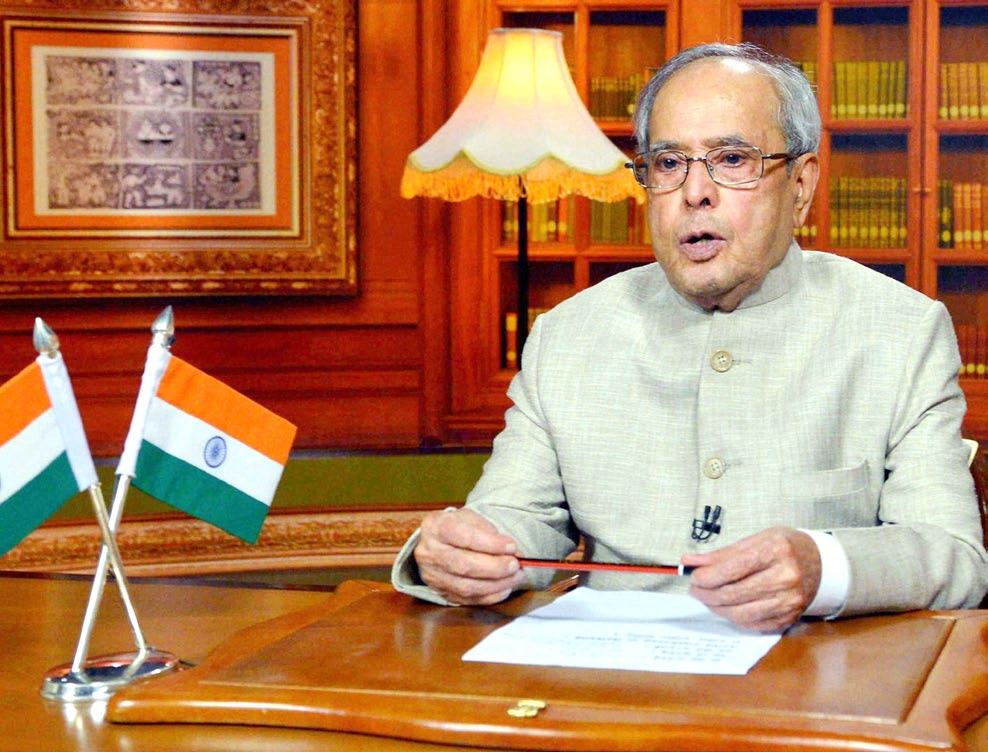
Detected with COVID-19, he was on ventilator following a brain surgery to remove a blood clot. Mukherjee was 84 years old.
From being an Assistant Professor in Vidyanagar College, Kolkata to the President of India, his journey was marked with his passion for electoral politics and his remarkable loyalty to the Congress party.
Mukherjee’s political career began in 1969, after being noticed for his by-election campaign management in Midnapore for an independent candidate: former diplomat and senior Congress leader V.K. Krishna Menon. Mukherjee became a member of the Rajya Sabha in July 1969, following which he was re-elected to the House in 1975, 1981, 1993 and 1999.
A trusted aide of Indira Gandhi, he appointed former PM Manmohan Singh – considered the architect of economic
reforms in the country – as RBI governor, during his stint as Finance Minister in the 1980s. His much-anticipated ambition to be Prime Minister of India after Indira Gandhi’s assassination never happened. Rajiv Gandhi’s decision to keep Mukherjee out of his cabinet was an acrimonious moment in the long relationship that the Congress stalwart enjoyed with the grand old party.
Later, not hiding his emotions on the development, Mukherjee wrote, “When I learned of my ouster from the Cabinet, I was shell-shocked and flabbergasted. I could not believe it. But I composed myself and sat alongside my wife as she watched the swearing-in ceremony on television.”
It had become evident to Mukherjee that he could not continue in the party and he parted ways to form the Rashtriya Socialist Congress in West Bengal in 1986. However, by 1989, he had reconciled differences with Rajiv Gandhi, and he was back in the party and the cabinet.
In fact, his name came up as PMprobable after Rajiv Gandhi’s assassination and yet again when the UPA came to power. But, in what had by now become routine, he was again overlooked by his party for the top job. However, the man
with a thick Bengali accent continued to relentlessly defend the party. He kept being the ‘brain’ for the party even in UPA-II, when the government was braving a string of corruption allegations.
He won back his primacy in the cabinet first under P.V. Narasimha Rao and later when Manmohan Singh was Prime Minister, as Commerce Minister, Foreign Minister, Defence Minister and Finance Minister. Singh was known to seek his advice and in the numerous GoMs that were formed in the course of UPA-I and UPA-II between 2004 and 2014, Mukherjee headed the largest number of them among all cabinet ministers.
In 2012, in the twilight of his political career, he was made the President.
During his tenure, Mukherjee brought in a refreshing change in the way one perceived Rashtrapati Bhavan. He earned the sobriquet of ‘People’s President’ as he charted his own course as Head of State.
During the widespread protests in the light of the Nirbhaya case, when crowds had gathered on Raisina Hill, he had insisted on going out and addressing them - he relented when he was advised against the step on grounds of security.
When PM Modi took over in 2014,
ousting the Congress-led government, the two unlikely personalities forged a relationship of mutual respect that saw the BJP government award the Bharat Ratna to Mukherjee and on that occasion, an emotional Narendra Modi thanked the man he fondly calls ‘Dada’ for “everything that you have done for the nation.”
In the book President Pranab Mukherjee – A Statesman, PM Modi gave a sneak peek into the special relationship the two shared. He had said, “It was during the Uttar Pradesh polls that he told me that win and loss happen all the time, but do take care of your health. It was not part of his responsibilities as President, but it was the humane person inside him which cared for a friend.”
He is survived by his sons, Abhijit and Indrajit, and daughter Sharmishta. Both Abhijit and Sharmishta have tried their hand at electoral politics. Abhijit Mukherjee suffered a shocking defeat last year in West Bengal’s Jangipur constituency while Sharmishta Mukherjee is the national spokesperson for the party her father once knew like the back of his hand. In 2015, Mukherjee lost his wife Suvra.
Anindya Banerjee
12 SEPTEMBER 2020 www.indianlink.com.au TRIBUT e
Pranab Mukherjee (11 Dec 1935 - 31 Aug 2020)
In the case of Sushant Singh Rajput

Why India remains so heavily invested in the death of SSR
BY BAGESHRI SAVYASACHI

It is almost three months now that Indian actor Sushant Singh Rajput was found dead in his home in Mumbai, a suspected suicide. Ever since, there has been nonstop coverage and public discourse about the circumstances of his death. Indian fans across the globe have voiced their support, concern and anger. There is clearly a phenomenon under way where this subject has completely dominated social media space and the attention of the press for such a prolonged period.
When I asked Indian journalist and writer Shoma Chaudhary what is so extraordinary in the case of Sushant Singh Rajput, she talked of his appeal as an as pirational youth who had broken into a tight-knit establishment and attained success.

“He was the classic case of the talented outsider breaking into a large power structure, and someone living out his dreams,” Chaudhary told Indian Link. “Very talented and quite unique, there was a whole aura around him because he was just so special in terms of the variety of interests he had. He was very good at maths and physics; he had cleared his IIT-JEE and all of that. Yet he gave it all up to pursue a dream and become at first, just a dancer, but slowly by sheer dint of his merit, broke into Bollywood and became a superstar. So, the whole trajectory is a very compelling one. The sudden suicide in the midst of lockdown (drew) everyone’s focus and attention. The hugely empathetic, tragic tinge to the story has certainly caught attention.”
Indians everywhere seem to be incredibly invested in the matter, even devastated. The
diaspora in California and in Melbourne in even put up billboards demanding justice for the actor. Sydney-based clinical psychologist Gurprit Ganda analysed a worldwide community’s passion and anguish in terms of the natural process of grieving.


“We all grieve in different ways,” Ganda said. “All these people are grieving, to some extent. The Kübler-Ross model of grief says there are stages of denial, anger, bargaining, depression and then acceptance. In the case of Sushant Singh, the investigation is still trying to find what the facts are - there are many gaps in the story and that does not help the grieving process. That is why they’re putting the pieces together in their own way. Some are in denial, in the first stage in grieving. Some are really angry, which is the next stage; they seem to besaying ‘it’s not fair’. And some are bargaining, like if that didn’t happen, then this wouldn’t have happened. There is a lot of uncertainty. If we know the facts about a person’s passing, such as if they had a health condition or some such, then we are able to go through the stages of grieving much better than when we don’t know the whole story.”
Regarding the more dismaying aspects of this case, it has now turned into a torrid and
high-octane story resulting in a national level murder investigation currently in progress, with an increasing number of allegations against Rhea Chakraborty, the deceased’s girlfriend. Shoma Chaudhury spoke of the media’s “mauling” of the young woman.
“This is a kind of medieval stoning mob that does not give any person a chance and is not evidence-based. So, sadly while pursuing the investigation for Sushant Singh, you know, you need a villain. The media houses have turned a young woman
into a villain. Sex, drugs, murder, golddigging, social climbing, nepotism, mental health, you name it, you’ve thrown every masala in the kitchen into this one broth. This happened once before with the Aarushi Talwar murder case, where two grieving parents were horrifically vilified by the media. They were put into jail; it took eight years for them to retrieve their life and they were finally exonerated. The Rhea case is going in a similar direction, so I think what started as an empathetic story has become a very ugly story of voyeurism now.”
With new information and angles surfacing everyday about the case and being plastered on our screens, it is clear that other news has taken a back seat. Like the crashing economy, for example, which is predicted to have the worst performance since 1947, because of a more than 30% contraction of the economy. And between the bans on Chinese apps, soldiers on the border have been killed because of our northern neighbour encroaching on Indian territory. Last, but not least, India’s COVID outbreak has been declared the fastest growing in the world.
SEPTEMBER 2020 13 NATIONAL EDITION SSR
Listen to this discussion and others like it on the podcast Don’t Miss The Link on our website indianlink.com.au
Shoma Chaudhary Gurprit Ganda
Law Student of the year
What drives Sanjay Alapakkam variety, an openness to learning, and an attitude of gratitude
BY MANAN LUTHRA
Fourth-year UNSW student Sanjay Alapakkam is far from the typical lawyer you might see on television. You won’t find him in an inner-city office, looking for legal loopholes to help the rich and wealthy. When he talks to you, he won’t dominate the conversation by speaking loudly or quickly. Instead, with his calm and thoughtful demeanour, he exudes wisdom clearly way beyond his years.
These are the qualities which have helped him win Australia’s most prestigious award available to law students – Lawyers Weekly’s Law Student of the Year.

“When deciding the award, Lawyers Weekly look at a few different things,”Sanjay told Indian Link. “Academic achievement and work experience aside, they also look at what makes you stand out as a law student, including your community involvement and where your passion for law and justice comes from.”

For Sanjay, it’s clear his passion lies in social justice. With both humility and deft articulation he glosses over his impressive CV, which includes time working in migration law with asylum seekers and refugees, an article on the law surrounding temporary protection visas published by the UNSW Law Society’s Court of Conscience Journal, and his most recent employment with the Inspector of Custodial Services, ensuring youth detention centres and custodial systems are properly run.
In addition, he is currently Vice President of the UNSW Law Society, having previously championed the rights and needs of UNSW’s LGBTQ+ law students when he served as the student club’s Queer Officer last year.
“I’m motivated by variety,” Sanjay said with enthusiasm. “Doing different things in a day acts like a stimulus for me – I get to start each day jumping into a new task.”
Though he recognises the huge amount of opportunities available to him in today’s legal industry, he knows it was once not as easy for a LGBTQ+ person of colour to make the same breakthroughs he has.
“There’s been a big improvement over the last couple of decades with regards to diversity in the workplace,” he observed.
“I think people are starting to value the idea that those with different life experiences have different things to offer, which encourages those who might have been turned off previously. Diverse leadership brings with it fresh perspectives and new ways of looking at things. That value has played a big part in moving this cause forward.”
So what can the industry do to boost diversity even further?
“The first step is encouragement –mentoring programs are hugely important,” Sanjay replied. “When people see others like them in the roles they might like to take on in future, a visceral feeling of motivation develops that is really important.”
He added, “It’s also important not to underestimate yourself based on your personality. Instead, look at your competencies and what you do well. That mindset really needs to be encouraged.”
His advice to current and prospective law students mirrors his message of selfimprovement.
“First, ask for help. People have been in your shoes before and are happy to tell you what their experiences were like.
“Second, look at every failure or setback as a learning experience. No matter who you are, you will face setbacks. See it as something to fix for next time, as a learning opportunity. You never know, your future success could be shaped by these setbacks.
“Third, grasp every opportunity you can and have an open mind. I think very few people know it all – even at the end of their careers. When presented with an opportunity think to yourself, what can I learn? What can it teach me? Go into a new activity with an open mind, grasp the opportunities it presents, and value the skills it helps build.”
This final piece of advice, he noted, is what ultimately gets him through the day.
“Working with people who have experienced the nadir of the human condition and seeing the resilience and courage they embody has helped me reflect on how lucky I am, and to ultimately understand it would be a waste to not take hold of every opportunity.”
GET SOCIAL WITH INDIAN LINK



14 SEPTEMBER 2020 www.indianlink.com.au STUD e NTS
indianlink.com.auIndianLinkAustralia @indian_link Indian Link
Getting the desi in you to laugh out loud
 BY RHEA NATH
BY RHEA NATH
To many young desis around the world, it’s a good laugh to poke a little bit of fun at ourselves. After all, we have plenty to chuckle about - from parents recommending turmeric as the cure to all diseases to sneaking Bollywood songs into any party playlist.
If your curry mom doesn’t give you an extra roti after you say you’re full, then you’re adopted.
Q: Where do idlis go to get drunk?
A Sam-Bar
Peanuts in your samosa is the brown version of pineapple in your pizza.
For the last two years, a Facebook group originating from Melbourne has been curating items of desi humour and winning fans from around the world.
Explaining the origins of the group, the founder of Subtle Curry Traits Noel Aruliah told Indian Link, “I was scrolling through Facebook one day and noticed a gap in the meme market. There were pages dedicated to jokes about private schools and different ethnicities, but there was nothing for the brown community,”
A student at Monash University, he admitted that he originally started the group as a “bit of a joke”. In a span of 24 hours, the group had 2,000 members. Within 3 days, it had 10,000 members.
“Subtle Curry Traits started growing rapidly. I decided to ride the wave and see where it goes. Our mission has been ‘healing with humour’, but it’s become a lot more than that,” Noel revealed.
Since its creation in October 2018, Subtle Curry Traits has garnered over 830,000 members.
Desis in the US make up the largest chunk of the group’s members, followed by Canada, Australia and other Western countries. Often, the members are firstgeneration immigrants.
“The experience we want to create is
a home away from home. You or your parents might not be from the country, you might look different. This is a place to look back and relate to your culture,” said Noel with a smile.
He gives the example of one of the group’s Indian moderators who lives in Hawaii. Knowing no other brown people around him, he came across the group as a source of feeling connected to his culture.
According to Melbourne-born Noel, the group’s name uses ‘curry’ in a positive way, creating a cultural shift in using the term and not feeling judged.
“We get asked often why we chose to name it ‘curry traits’. In Melbourne, it’s a term for brown people and isn’t racist. I grew up with the term. It’s not derogatory or condescending,” he explained.
He sees Subtle Curry Traits as a platform for “different nationalities of curries to put differences aside.”
“It can normally be hard to get two people from ‘curry’ nations to agree on anything!” Noel said with a laugh.

With its massive popularity amongst desis, especially under the age of 35, some big names have collaborated with the group.
“Some people from Netflix’s Indian Matchmaking have reached out,” Noel shared. “We’ve had Sopan Deb from The New York Times. We’ve collaborated with some trending desi artists… But Hasan


Minhaj has definitely been the biggest name.”
The private group has 12 moderators spread across the globe who keep an eye out for content that’s infectious, original, relatable, and in Noel’s words, “funny enough to just lose it.”
“Our moderators do a great job, but we get hundreds of thousands of submissions,” he shared. “We joke that it’s harder to get your jokes published on Subtle Curry Traits than to get admission into Harvard!”
Now considered a cultural phenomenon for its ability to bring together desis through humour, Subtle Curry Traits is aiming to be more than just a funny Facebook group.

“We ask ourselves – what can we do for our community to build unity? How can we help the world? If we can influence people to see our memes and then watch a show like Indian Matchmaking, how can we use this influence for the global good?”
Outside of Facebook, they partnered with a leading desi doctor in the US on how to tackle the coronavirus, offering health tips to empower and educate their multicultural members. They’ve broadened their scope to include merchandise like t-shirts and sweaters to rep the brand as well.
For Noel, Subtle Curry Traits boils down to one simple message: “We want to create a global community, connected through humour and heritage.”
SEPTEMBER 2020 15 NATIONAL EDITION y OUTH
History, heritage and humour: The facebook group that almost a million young desis are into
Photos: Subtle curry Traits
Noel Aruliah
Making online spaces safer
BY RHEA L NATH
Social media can be a great place to feel connected to others and express yourself freely, but at its worst, it can become an online platform for hate and abuse. On a daily basis, it’s easy to come across vile content, especially those targeted at women.

Thankfully, a new Twitter algorithm created by Queensland researchers hopes to nip this in the bud.
“Currently, it’s on users to report abuse they receive. With our solution, we can protect women by identifying misogynistic content online,” explained Professor Richi Nayak, a machine-learning researcher at Queensland University of Technology.

“Female users in particular can receive really brutal messages online. Just look at the treatment of female celebrities, or even Australia’s first female Prime Minister.”

A deep learning algorithm was created by Nayak along with Professor Nicolas Suzor and research fellow Dr Md Abul Bashar in a collaboration between QUT’s faculties of Law, Science and Engineering, and the Digital Media Research Centre.

The algorithm, called ‘Long Short-Term Memory with Transfer Learning', mined 1 million tweets and narrowed them down by three abusive words – rape, slut, and whore.
The researchers also generated a rule-setto include parameters beyond abusive words.
“We looked at whether the content was targeted to a particular person or group, if there were specific threats or a wish for violence, if it included objectifying or sexual material, if it advocated hateful conduct, and so on,” Prof. Nayak told Indian Link.
This kind of ‘context learning’ has been crucial, as the presence of certain abusive words alone doesn’t mean that the content is misogynistic. Online, such tweets could be meant as a joke, or they could be sarcastic.
“You know how kids talk on social media these days,” the researcher chuckled.
Presently, a phrase like ‘go back to the kitchen’ might not typically be highlighted as problematic content because it doesn’t contain outright abusive language. Most
systems would not typically identify such a tweet as misogynistic when it can’t understand the necessary context.
“Our algorithm proves that systems have the capability to understand context. This is crucial as learning misogyny is very different from merely identifying abuses online.”
To combat this hurdle, the Twitter algorithm was taught to identify linguistic patterns.
“It was developed to learn language patterns. It first learnt formal English language patterns, then we added more information like the language patterns employed in tweets which may not always be the most grammatically correct,” Nayak elaborated.
Over time, their model learns and develops its contextual and semantic understanding of
language with continued exposure to content. The research team has currently reported 75 per cent accuracy in identifying misogynistic content through the algorithm, outperforming other tools that investigate similar aspects of social media language.
In the future, there’s scope for such an algorithm to be adapted to understand and identify racist or homophobic tweets too.
“With new described data sets, the algorithm has the ability to understand other context as well,” the researcher confirmed.
According to Nayak, research like this has the ability to alter the way we utilise social media on a daily basis.
“Currently, social media platforms can identify some patterns, and they have systems in place to get warnings about hateful speech, but they have a huge volume of content to go through. Moreover, there’s been arguments surrounding the freedom to share your views freely online,” she said.
The hope is that such an algorithm can improve a typical female user’s experience on social media.
Although it has been specifically programmed for Twitter at present, the algorithm couldeventually be deployed as a plug-in for users. In fact, Nayak says it could be expanded to accommodate misogyny in other languages like Hindi.
“I’m a machine learning researcher, so I use text mining to make sense out of large amounts of data. I was keen on using data science towards social good,” she said with a smile.

16 SEPTEMBER 2020 www.indianlink.com.au
A new algorithm by researchers at Queensland University of Technology could hold the key to preventing online abuse of women on Twitter.
T ec H
Prof. Richi Nayak


SEPTEMBER 2020 17 NATIONAL EDITION
Indian origin scientists develop improved space batteries
NASA has funded research led by a team of Indian-origin scientists in the US who have developed lighter, faster-charging batteries for use in space. The improved space batteries are suitable for powering a spacesuit, or even a Mars rover.
Shailendra Chiluwal, Nawraj Sapkota, Apparao M Rao and Ramakrishna Podila, all of whom are part of the Clemson Nanomaterials Institute (CNI) at the Clemson University in South Carolina were part of the team that created these batteries.
Podila, an assistant professor in the College of Science’s Department of Physics and Astronomy, said the revolutionary new batteries could soon be used in US satellites. Most satellites mainly get their power from the sun. But the satellites have to be able to store energy for when they are in the Earth’s shadow.
“We have to make the batteries as light as possible because the more the satellite weighs, the more its mission costs,” Podila said.
The research, which was funded by NASA, appeared in the American Chemical Society journal Applied Materials and Interfaces.
Podila said that to understand the group’s breakthroughs, one could visualise the graphite anode in a lithium-ion battery as a deck of cards, wherein each card represents a layer of graphite that is used to store the charge until electricity is needed.
The problem, Podila said, is that “graphite cannot store much charge”.
The team opted to work with silicon, which can pack more charge, meaning more energy can be stored in lighter cells.
Rather than a deck of cards made of graphite, the new batteries uses layers of a carbon nanotube material called “Buckypaper”, with the silicon nanoparticles sandwiched in between.
Using batteries made of silicon and other nanomaterials not only increases capacity, it also allows for charging batteries at a higher current, which translates to faster charging times.
As anyone whose cellphone has ever died in the middle of a phone call knows, this is an important feature for battery technology, the authors said.
Lighter batteries that charge faster and offer greatly increased efficiency will not
only be a boon to astronauts wearing battery-powered suits but also to the scientists and engineers who have to get the astronauts to their destinations.
“Silicon as the anode in a lithium-ion battery represents the ‘holy grail’ for researchers in this field,” said Rao, CNI’s director and the principal investigator on the NASA grant. He added that the new space batteries will soon find their way into electric vehicles.
India’s 1st female cardiologist dies of COVID at age 103

Dr S. Padmavati, India’s first female cardiologist, has passed away due to COVID-19. She was 103 years old, and had been battling the disease for 11 days.
“Our very own Madam Padmavati has left us all, after her centurial terrestrial journey. She fought corona bravely but chose to move on at 11.09 p.m. on August 29. Let us keep her in our prayers forever and long,” said O.P. Yadava, Chief Executive Officer of Delhi’s National Heart Institute.
According to another statement by the National Heart Institute, she was admitted with COVID-19 and had breathing difficulty and fever.
“She developed pneumonia in both lungs and needed ventilator support. However, she sustained a cardiac arrest and passed away,” it said.
The noted cardiologist had set up the National Heart Institute of the All India Heart Foundation and had served as its Director and President. She was also a recipient of the Padma Vibhushan, the second-highest civilian award in India.
Born in Myanmar on June 20, 1917, Padmavati earned an M.B.B.S degree from Medical College Rangoon. She had to leave the country due to the Second World War and settle in India.
She pursued post-graduate studies in the UK and specialised in cardiology in Sweden and the US at the Johns Hopkins Hospital and Harvard University after the war ended in 1945.
Her research work has been on rheumatic heart disease, cor pulmonale, hypertension and coronary artery disease with special reference to epidemiology and prevention.
The acclaimed doctor has published extensively in prestigious journals in India and abroad.
She taught undergraduates, post-graduates and post-doctoral fellows for over 45 years.
Apart from the Padma Vibhushan in 1992, she was also the recipient of the Padma Bhushan in 1967, and Harvard Medical International Award in 2003.
Indian start-ups recruiting talent from banned Chinese apps
A number of Indian start-ups in the field of social media have confirmed that they are attracting talent from banned Chinese competitors amid uncertainty over their India operations in the long run.
Chinese app Byte Dance, which owns TikTok and Helo, has nearly 2,000 employees in India.
“We’ve got various interests from the employees of ByteDance and other competitive companies. We have received close to 100 resumes from them,” said Sumit Ghosh, CEO and Co-founder of Chingari.
The homegrown short video app Chingari had recently raised 1.3 million (around Rs 10 crore) in a seed round. It has approximately 25 employees.
Another Indian short video-making app Rizzle has said that about 10 former TikTok employees have joined it.
“Rizzle attracts a number of sharp engineers, marketers, and other talented individuals from a variety of companies across India, which includes Byte Dance among others. An approximate of 10 employees have joined us,” said Lakshminath Dondeti, Co-founder of Rizzle.
Soon after India announced the ban on TikTok, along with 58 other Chinese apps, in July, TikTok CEO Kevin Mayer said that employees are the company’s “biggest strength” and their well-being is its “topmost priority”.
However, these assurances appeared to be not enough to calm the minds of many of the company’s anxious employees.
Another short video-sharing app Mitron, which became popular in the wake of the anti-China sentiment, is also looking to hire “the best talent in the country.”
“At Mitron, we are hiring the best talent in the country across product, engineering, marketing and other functions and give them a platform where they can impact the experience of millions of users,” said Shivank Agarwal, Co-founder and CEO,
spent 45-years serving for the poor, sick, orphaned and dying, died in Kolkata on Sept 5 1997, aged 87.
Mitron. “We look for specific skills that the role requires irrespective of which company they come from.”
It has now emerged that what is TikTok’s loss could be gains for the Indian start-ups that are trying to fill the gap left vacant by the ban.
However, all these apps will have to deal with the challenge of holding on to their users and attracting top-notch creators to emerge successful in the long term.
APAC firms are changing their marketing strategy due to the pandemic
With habits of consumers changing significantly due to COVID-19 disruptions, organisations in the Asia Pacific (APAC) region are transforming their long-term marketing strategy.
According to a survey by Adobe, the results showed that around 80 per cent of organisations in countries like India and China are likely to have a COVID-19 taskforce to manage messaging and campaigns.
Organisations in these two countries are also expected to be significantly quicker in returning to pre-COVID level of investment in marketing than those in other countries.
“This year has brought about a broad shift in consumer behaviour and attitudes. In line with this, marketers are modifying their customer experience strategies to address different groups with relevant messages, more so than ever before,” Sunder Madakshira, Head of Marketing, Adobe India, said in a statement.
“It is clear from the results of this study that brands that are agile in pivoting to a digital modus operandi and have responsive campaigns that deliver authentic, meaningful and responsible communication stand to succeed in the long run.”
In response to the social distancing mindset, more than half of the respondents have shifted imagery or language in their recent marketing campaigns.
Those in Australia were less likely to have shifted messaging, with those in China and India being more likely.
The most commonly shifted elements are visuals of people touching and language that describes close interactions.
Given the situation, there seems to be a general sense that brands have a duty to proactively offer help or provide special offers to customers at this time. According to the study, this sense of duty among marketers is strongest in China and India, and weakest in Australia.
Almost seven in 10 marketers are currently working from home across India, Australia, China and Singapore as compared to nearly half of them working from home on a weekly basis or more prior to COVID-19.
The study surveyed 1,200 marketers across China, India, Singapore and Australia who are directly involved in their
18 SEPTEMBER 2020 www.indianlink.com.au INDIAN Ne WS
Remembering Mother Teresa: Superior General of the Missionaries of Charity Sister Mary Prema helps Archbishop of Kolkata Thomas D' Souza light a lamp on the tomb of Saint Teresa. The Nobel Peace Prize winning Catholic nun, who
Photo: AP
The world’s highest bridge: A general view of a railway bridge under construction on the Chenab River to connect Udampur-SrinagarBaramulla in the Reasi district of Jammu and Kashmir. The Indian Railways project is likely to be completed by August 2022. The 1.3 km long rail bridge will be able to withstand an earthquake measuring more than 7 on the Richter scale.

AP
brand’s marketing activities, and have an analyst role or higher.
Indira Gandhi Peace Prize 2019 presented to David Attenborough
Noted broadcaster and natural historian David Attenborough has been presented the Indira Gandhi Peace Prize 2019 by the Indira Gandhi Memorial Trust.
Attenborough has been given the prize for "revealing the wonders of the natural world, educating and entertaining generations of people through his films and books for tirelessly working to awaken humankind to the need to preserve and protect the biodiversity on our planet, and advocating the necessity to live a sustainable and harmonious way of life, working with rather than against nature," the citation read.
Speaking on the occasion, former Prime Minister and senior Congress leader Manmohan Singh underlined the importance of climate and environment in the backdrop of the current COVID-19 pandemic.
"It doesn't need an epidemic to tell us that we are not in good shape. Climate change, the assault on the oceans, the pollution of the atmosphere, the junk floating about in space, the reduction of forest cover, the extinction of life in rivers, the reduction of natural habitat for any life other than humans - all this is evident to anyone," the former Prime Minister said.
Congress President Sonia Gandhi, referring to late former Prime Minister Indira Gandhi after whom the prize has been named, said: "India needed to accelerate the pace of investment, and expand its economic infrastructure. But at the same time, she (Indira Gandhi) was very sensitive to the imperative of maintaining what she would often call ecological balance."
She added, “Sir David through his prodigious creativity in educating humankind with brilliant films and books about the natural world. And he has, of late, been the most sensible voice warning us that we, more than anything else, are responsible for the accelerating threat to the environment on our planet.”
Indian tour company announces ‘Bus to London’ service
A private Indian tour company has announced a bus service from Delhi to London where the travellers will cover 18 countries and 20,000 km in 70 days. Adventures Overland, based in Gurugram, has announced the “first-ever hop-on/hop-off bus service between Delhi and London”, named Bus to London. People taking this tour will travel through Myanmar, Thailand, Laos, China, Kyrgyzstan, Uzbekistan, Kazakhstan, Russia, Latvia, Lithuania, Poland, Czech Republic, Germany, Netherlands, Belgium and France. A special 20-seater bus, equipped with
business class seats, is being built for this trip. Apart from the 20 passengers, there will be a driver, an assistant driver, a guide and a helper. The guide will change at regular intervals during the trip.
The company will also take care of the visa arrangements of the passengers.
The trip will be divided into four categories and passengers can choose different destinations according to their liking and convenience. If they avail of the whole trip from Delhi to London it will cost them Rs 15 lakh (approximately AUD 28,000) per person.
The idea materialised after travel enthusiasts Tushar Agarwal and Sanjay Madan took a road trip to London in 2017, 2018 and 2019.
“We planned this trip after a lot of people passionate about travelling expressed their wish for a road trip to London. This was announced on 15 August and we hope that the first bus to London will be flagged off in May 2021,” said Adventures Overland cofounder Tushar Agarwal.
They have not started taking registrations yet and plan to commence once they can take stock of the coronavirus situation in all the countries visited.
“All the facilities will be provided during the 70-day trip. Arrangements for stay will be made in 4-star or 5-star hotels and passengers will also be provided Indian food in all the countries,” Agarwal added.
Indian-origin German cricketer makes women's T20 history
Indian-origin cricketer Anuradha
Doddaballapur, captain of the German cricket team, has made history by taking four wickets in four balls in a match against Austria. Her feat helped Germany win by 137 runs in the fourth T20 international of their Austrian tour.
This marks the first time in women’s T20 international cricket that a bowler has taken four wickets in four consecutive deliveries.
She finished with an incredible 5/1, surpassing Lasith Malinga’s 5/6 against New Zealand in 2019. This gives Doddaballapur the record of best T20I figures by a captain. This feat has only previously been done by Sri Lanka’s Malinga and Afghanistan’s Rashid Khan.
In this series against Austria, the German
women’s team broke a number of records and won all five of their matches. The T20 series also marked return of women’s international cricket since the ICC T20 World Cup 2020 final between India and Australia, held in Melbourne Cricket Ground back in March.
“I’d like to thank everyone at Austria Cricket for hosting us despite the current circumstances. We are excited to take the field again after a seemingly long break,” 33-year-old Doddaballapur had said at the beginning of the series.
The German team, known as the ‘Golden Eagles’ and led by Doddaballapur, rank 27 in the ICC T20I women’s rankings. They last played an international match in February against Oman, as part of a 4-0 series clean sweep.
According to a recent ICC media release, women’s cricket is growing rapidly, with overall participation increasing 155 per cent since 2016.
Akshay Kumar unveils ‘FAU-G’ as alternative to banned PUBG
Akshay Kumar has announced a multiplayer game titled ‘FAU-G: Fearless and United Guards’ that will support Prime Minister Narendra Modi’s ‘Atmanirbhar Bharat’ movement.
The game aims to provide an Indian alternative to popular mobile game PlayerUnknown’s Battlegrounds (PUBG). FAU-G has been developed by nCore Games under the mentorship of Kumar. 20 per cent of the game’s proceeds will be donated to a trust for Indian soldiers.
The game is expected to be based on real scenarios encountered by the Indian security forces to deal with both domestic and foreign threats and it will be available on the Google Play Store and the Apple App Store.
PUBG has been pulled out from both Google Play Store and Apple App Store in India following the directive from the Indian government. It is no longer available to download for the Android and iOS users in the country. However, the game can still be played for users who have it installed on their smartphones sans updates.
PUBG was banned on an order by the Ministry of Information and Technology (MeitY), which also banned 117 other popular apps from China over national
security concerns. In June, 59 apps were banned including TikTok and another 47 apps were suspended in July.
The PUBG game, which has more than 600 million downloads and 50 million active players globally, has millions of users, especially young, in India. It was not banned in India earlier as it is not entirely Chinese, having been created and managed by Bluehole, a South Korean organisation.
China has termed the action as ‘discriminatory restrictions’ on Chinese companies and alleged that it violated World Trade Organisation (WTO) rules.
Indian Supreme Court puts Netflix series ‘Bad Boy Billionaires’ on indefinite hold
The much-awaited Netflix series Bad Boy Billionaires: India has been put on hold after representatives of Ramalinga Raju (known for the Satyam Computers scandal) and a representative of the Sahara Group (whose chief Subrata Roy is under investigation) filed injunctions against its release.
The series was set to explore the investigations and scandals of big names like Vijay Mallya of Kingfisher, Subrata Roy of Sahara India, jeweller Nirav Modi, and Ramalinga Raju of Satyam Computers.
While Netflix has refused to comment on the issue, the show’s director Dylan Mohan Gray took to Twitter to express his displeasure, although those tweets have since been deleted.
Indian filmmakers have come out in support of the series, arguing that these true stores “must be told”. Anubhav Sinha, the director of Thappad, pointed out that the scandals have been covered in TV and print media, but are now being censored in cinema.
While Subrata Roy’s counsel had approached a local court in Bihar regarding the series, Ramalinga Raju had approached a Hyderabad civil court for the same. The series does not have a special episode for diamond merchant Mehuk Choksi, but the businessman had approached the Delhi High Court, seeking a preview of the series before it can be released.
Netflix’s legal counsel has said that Bad Boy Billionaires: India “has not tried to defame anyone” and is merely “an investigative docuseries based on interviews as well as the facts which are available in public domain.”
IANS
SEPTEMBER 2020 19 NATIONAL EDITION
Photo:
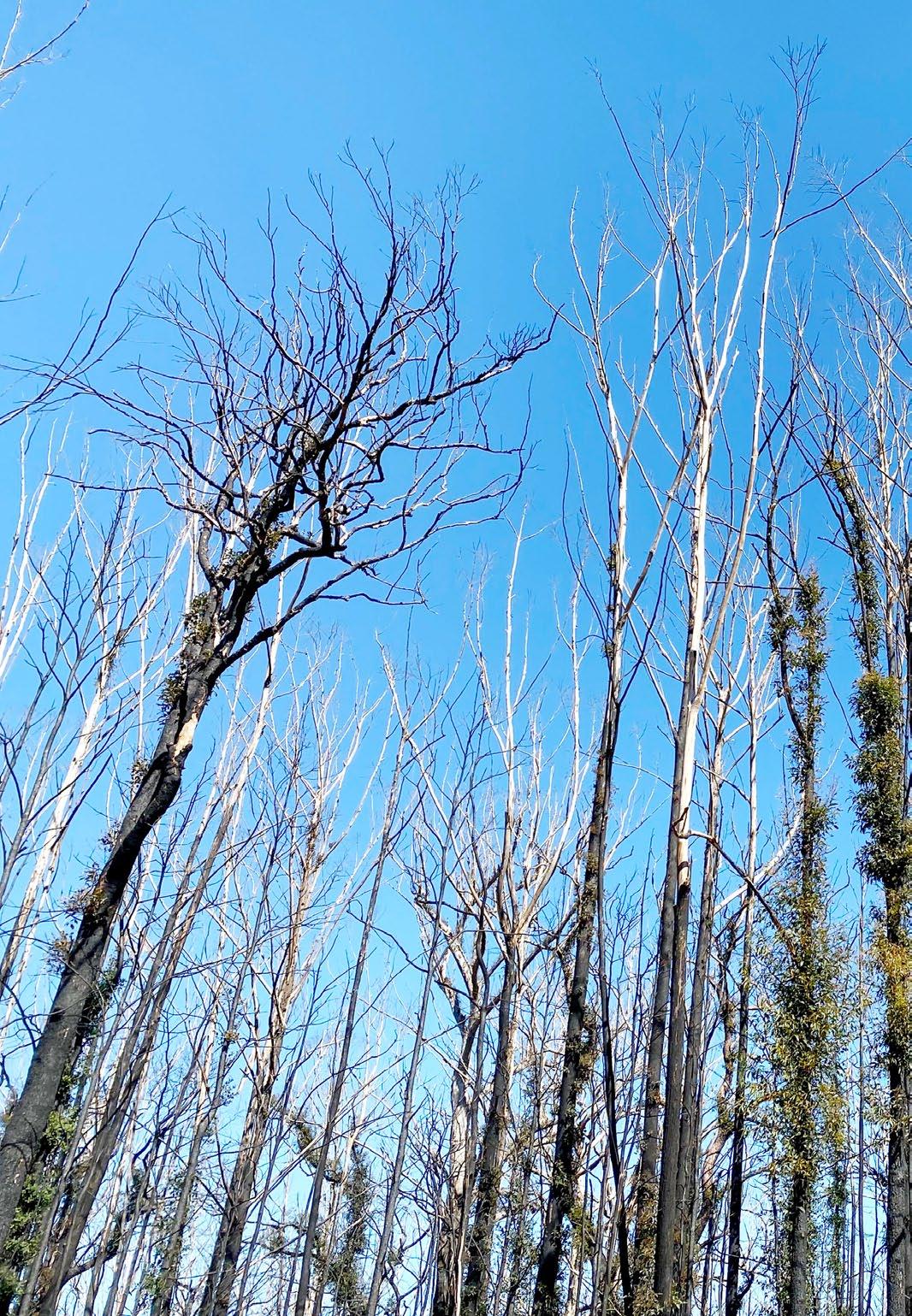
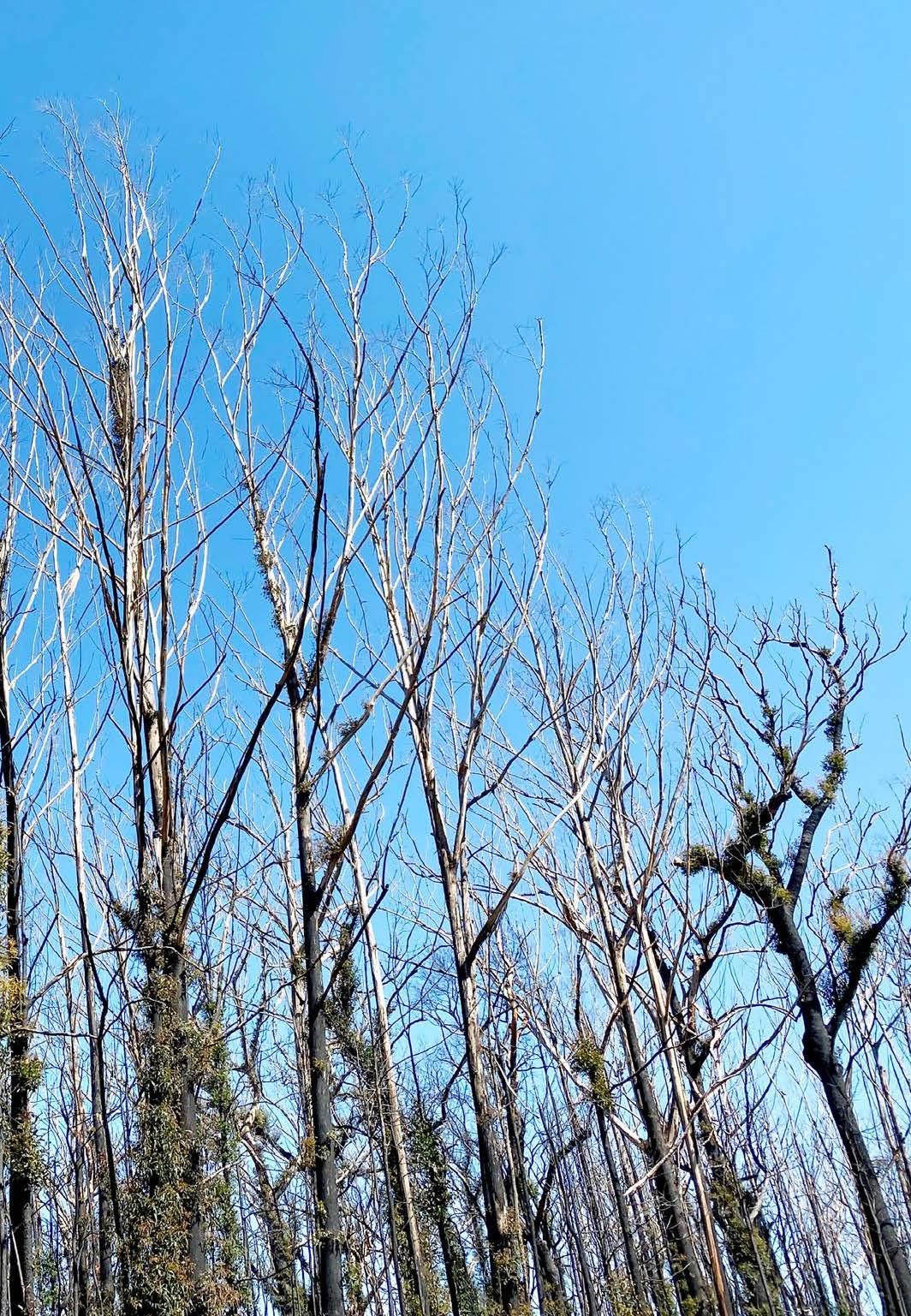

(r ajni a nand Luthra, mo LLymook ns W) RESILIENCE:
Fire-ravaged bush in recovery mode
Hope and reassurance, not angst and division
The decision to cancel year 12 formals, as with much else in recent weeks, lacks educational as well as political vision
BY MOHAN DHALL
The school curriculum and university courses evidently do not generally teach those in power how to lead, or demonstrate vision.
Lacking in both, in my view, was the announcement of the banning of Year 12 formals by an educational ‘leader’ in a time when student stress and the need for social inclusion has increased.

That the announcement was completed, and juxtaposed with, a ‘need to focus on exams’ demonstrates a smallness of understanding.
I have indicated earlier that youth suicide has increased and students feel afraid and uncertain. Under such circumstances, exams need to be seen in the context, global and local.
Do some educational ‘leaders’ not understand this? Surely they are across this data? Surely, a pandemic requires something more than a focus on exams?
It is as if the assessment of ‘stuff’ prevails over an understanding of the times.
Whilst the announcement may have been well meaning, an understanding of emotion and its impact on student learning needs to be integrated into decisions affecting students. Why cause angst amongst students and distract them from
the study so evidently valued? Why create distress amongst parents?
In a year when physical and social distancing has created discontinuity, a message of how formals, as a necessary transition between school and an autonomous life, would be made to work rather than be cancelled, would have reflected the education system as a learning system.
This smallness evident in some aspects of educational leadership is pervasive in society. At a time when individuals and communities need hope, clear vision, reassurance and calmness, the political dialogue swings from reactive to aggressive. The broader chatter – on social media and reflected in classrooms – should make it abundantly evident: students and communities in Australia, as elsewhere, need messages of hope, encouragement, perspective.
It should be obvious to those in power that, though unexpected and unwelcome, the coronavirus pandemic was perfectly
predictable. It should also be perfectly obvious that when a world ‘leader’ undermines the legitimate press through a self-interested characterisation of ‘fake news’ then people will lose trust in authority. If those charged with carrying out the law subvert the law, then trust will further erode. Students see police officers shooting unarmed civilians in the back. Students do not say, “that was there, but this is here”. Everything feels close and nothing can be trusted.
At a time when some of the largest governments are also the most controlling, it should be obvious that there will be international tensions and even the possibility of war. Be it economic or armed, war is characterised by propaganda – a divided world of us versus them, or right and wrong.
Faced with these circumstances, authentic leaders must demonstrate vision, and the capacity to ‘lead’ well.
Leadership is different to management. Leadership requires that those in power follow a vision that incorporates a clear
understanding of history, human behaviour and what brings out the worst in people. Invoking angst, enmity, division or fear are the antithesis of leadership. Creating hysteria might pander to some but most simply lose hope. Shutting down hope and then justifying why, does not inspire communities. It makes them initially powerless and then angry.

Leaders need to understand and live with the idea of loneliness. Decisions made should be made for the greater good, not a system, an ideology or an administrative set of boxes to tick. Great leaders understand loneliness, for their connection is with an ideal, not the polls or popularity.
However, whilst embracing loneliness for the self, leaders encourage community, understand how messages of hope uplift and find a way to help people know there are better times ahead. Today’s discipline is tomorrow’s celebration. Today’s discipline is also today’s celebration, for discipline never restricts when lived in the context of a better life.
It would be great to see more joy. A focus on kindness, community and finding things to celebrate. Since thinking can be shaped by what we choose to see, leaders need to see how happiness can engender hope at this time - when the circumstances will be bleak for a while.
Messages of importance are not undermined by warmth. Finding humour and lifting spirits when there may not be much to smile about is the beginning of leadership.
22 SEPTEMBER 2020 www.indianlink.com.au OPINION
It appears that angst, enmity, division and fear are being invoked by some of our leaders, who need instead to inspire with kindness, hope, community-mindedness and finding things to celebrate
Why I chose Hindi for my HSc
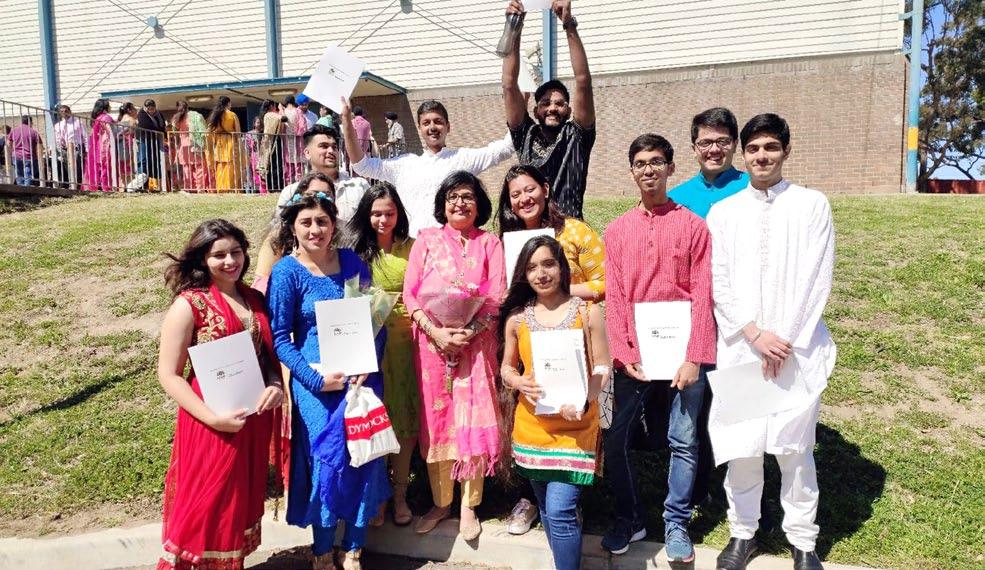
 BY EKAAGRA KESARWANI
BY EKAAGRA KESARWANI
You might not know this, but the NSW Government’s Department of Education offers Hindi as a subject in High School.
Hindi, you’re thinking? I wouldn’t be caught dead studying Hindi for the HSC! It’s not cool. Nobody else does it. My Hindi is fine, and it’s probably just going to be a waste of time. I’d rather study something like French, German or Japanese if I wanted to study a language?
That’s exactly what I thought in Year 10. Now, reflecting almost a year after receiving my HSC marks, it was one of the best subject choices I made.
For more than one reason.
For those that just want to choose a fun subject, Hindi is for you. You’d be surprised to know that I had a really good time studying Hindi. While attending classes one day a week, I met more likeminded people than I did in all of high school.
In true Indian fashion, within a couple of lessons we had a WhatsApp group. It was common to see a notification for 400 unread messages within an hour on the group chat. Having grown up with the same movies, cartoons, comics and of course language, we had much in common. We all knew the inside Indian jokes; we all loved the same food and knew the lyrics
to popular Hindi songs. Nicknames for each other came quickly as we discovered each other’s weird, nerdy and surprising hobbies. Needless to say, we got along.
We had lessons where we just watched Chhota Bheem, lessons where we ate panipuri and lots of lessons where we played Bollywood Dumb Charades.
It was great fun.
Another good reason you should pick Hindi, and hold onto it until the HSC, is because of how easy it really is. If you bring with you the ability to read, write and speak even to an intermediary level, then furthering your knowledge and skills in Hindi should be a breeze. The content is not challenging, but rather interesting.


Encompassing poems, grammar, comprehension, research and speeches – classical as well as contemporary – it turned out to be an exciting course.
Competition was the only challenge, and there was a healthy amount of it.
Equally, I might add, if you struggle with reading or writing, Hindi is incredibly easy to pick up. In the worst-case scenario, you decide to pick the subject, you study for a term, you learn a few things, then you don’t like it and you drop the subject! Nothing is lost but a small part of your Saturday, but you were probably going to wake up late and waste your time anyway. You might’ve even raised your level of Hindi a few notches. Your day school studies won’t
suffer either.
If you do make the thoughtful decision of studying Hindi throughout your Prelims and HSC, you will gain a fair few things. Firstly, it could greatly boost your ATAR with minimal effort. While it’s true that the subject doesn’t scale the best, it is much easier to get a band 6 in, compared to say, Economics or Drama.
I can honestly say that coming third in the state and knowing the person who came first, Hindi might have been one of our easiest subjects during the HSC. For anyone who wants to achieve an excellent ATAR by their own standards, it should be a no-brainer to pick a subject that you know well, your parents are experts at and that you are guaranteed to do at least OK in if you put in zero effort. Hindi is exactly that, and I say so from experience.
And yet, while there are thousands of Hindi-speaking students in the state, very few choose Hindi. Why do we have such a small Hindi cohort in comparison with the hundreds of students studying Tamil, Punjabi, Mandarin?
I would urge you to look into studying Hindi. While there are other platforms teaching Hindi (private tutors, temples and community classes), you will never get the same experience as studying at Saturday School. You will make great friends, meet excellent teachers, get great marks and have a good time.
P.S. You may be able to complete your HSC for Hindi in Year 11, if you start in Year 10 and thus take some pressure off in Year 12.
SEPTEMBER 2020 23 NATIONAL EDITION Sc HOOL
It was fun and a welcome respite from the burden of other subjects, it was great fun, gave me a better cultural connection and improved my ATAR
Chopping for charity
To mark International Day of charity 2020 this year, SURUCHI SEHGAL donated her long locks to patients of chemotherapy

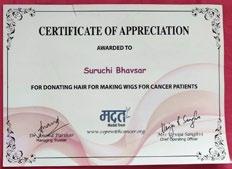


Coming from an Indian background, your crowning glory is your pride and exudes a different kind of confidence.
But what used to be a powerful symbol of womanhood, is now slowly changing. Women are opting for not only shorter hair, but also shaved heads, and owning it boldly.
When I learnt that hair can be donated, it got me excited and I couldn’t wait for it to grew longer.
I still had some doubts and questions about the process. Where does my hair go once it is cut? Who gets the wigs? Who makes the wigs? Where do they make them? How many people does it help? Which NGO/organisation/salon is best?
Before I made that final cut, I sought out the answers.
Back in India, salons in most metro cities are associated with NGOs and organisations that fashion them into wigs. I read all about the requirements, and started taking better care of my hair. As soon as I reached a required length, I placed an appointment with a salon that was famous for hair donations. Later, I received a certificate from the NGO stating that my hair had been donated. It was a wholesome experience and the best way to celebrate my 30th!
It’s not only women who can donate their
mane, even hipsters with man-buns can donate their 12-inch tresses. In southern India, the practice of sacrificial offering of chopped hair is symbolic of killing your ego and doing away with vanity. But helping someone who is battling a disease is kinder and more empowering.
When I moved to Sydney, it was the upcoming bushfire season that prompted me to say goodbye to my long locks of two years. I did remember though, what an
amazing experience hair donation was. Simply googling ‘hair donation Sydney’ popped up many options. However, most of the alternatives offered an address where you could send your chopped braids. I was a bit reluctant and sceptical doing it on my own, so I looked for salons that helped with the haircut and the donation part. I was overjoyed when I came across Sustainable Salons, a resource recovery program for salons across the world! The website has a salon locator and you can place an appointment with a sustainable salon near you. You will receive a certificate for the donation you make. With my father’s recent detection of cancer, back in India, and his hair loss due to chemotherapy, this was akin to my contribution to his well-being and recovery, from here in Sydney.
My hair is now on its way to a non-profit
– Variety Children’s Charity – working for children with hair loss due to long term medical conditions. The charity works with a wigmaker to provide custom-made, suction wigs that can be worn during everyday activities including swimming and other sports, with the hope of building confidence and self-esteem.
Hair loss is one of the most visible signs of chemotherapy treatment and can not only be emotionally tough but also painful as the hair sheds from the scalp.
Kids suffering from medical conditions generally opt to purchase wigs that are not only expensive but also last for around three years only. Hence, charities are always looking for donations of human hair to make wigs. On average, it takes 10 to 20 ponytails and many months to make a human hair wig.
Wigs can help some very sick children ease back into society after their recovery.
Australia’s Leukaemia Foundation also hosts the annual campaign World’s Greatest Shave nationwide, a fundraising event where people shave, cut or colour their hair to raise awareness and vital funds for the campaign.
So think about chopping your locks, and gaining some gratitude!
Learn more about Sustainable Salons at www.sustainablesalons.org
24 SEPTEMBER 2020 www.indianlink.com.au f IRST P e RSON
Helping people adapt and prepare for inherited risks
In this column, we look at the interesting vocations in which our community members are involved. RISHA ZIA tells us about her work as a Genetic counsellor

My job title
Consulting Genetic Counsellor (clinical)

I have been in this job for Eleven years in NSW Health
My educational qualifications
I completed my graduation in Zoology with Genetics as my specialisation and I then did my masters in Genetic Counselling. I’ve also completed courses in mental health.
What the job entails
My role as a genetic counsellor is to provide information, service and support for patients and their families with or at risk of developing an inherited health condition, such as cancers. I meet patients with cancer and draw a family tree, do an assessment on the family history, taking into account the age of diagnosis of the family members and the histopathology of cancer.
I use several computer algorithms as an aid for my assessment. Following medical guidelines, I test patients for a certain gene or genes (genetic testing is a blood test). It is very significant to clarify the patient’s perception of genetic risk and assess the psychological effects of trauma of family members dying of cancer. This often entails referral to psychosocial services.
If a gene fault is identified in a family member, we then see other family members and offer them testing. Since there is only a 50 per cent probability (in most cases) of inheriting these genes, family members who are positive are then screened to pick up the cancers early to prevent metastasis. Often prophylactic surgeries are recommended to prevent cancers. We also offer them PGD, a technique that can prevent the faulty gene from passing on to the next generation.
Part of my role is research, and helping researchers recruit patients to their study. If a gene fault is identified, then we confirm the clinical finding by retesting through our labs. We often have to present papers or posters in conferences and also have to keep up with the latest technology and new information to help our patients.
We are also involved in educating the doctors regarding new genes identified and constantly retesting patients.
But all this is the boring part of the job. The interesting part is that the families get to know you well and they don’t hesitate to approach you for any clinical or personal questions they may have. We then become the heroes of these families. It feels great!
What’s hard about my job
We become close to the family members after years of contact. To then get a phone call from a loved one to inform us of the death of the patient is hard to come to terms with. When a young single mother dies leaving little children behind, it makes you feel miserable.
After this ordeal, continuing business as usual
can be very tough.
The hardest part though, in my experience, has been building a rapport with non-English speaking patients on their death bed. You simply cannot convey care through interpreter services. I feel terrible as sometimes, sufficient care is not given to disadvantaged patients.

How has COVID 19 changed my work practice
The joy of human interaction in a clinical setting has been replaced by computers. All consultations are now done by Telehealth.
The workload has increased, as exchange of histopathology reports and request forms for genetic testing are scanned and emailed. Technical issues dealing with Telehealth is an area that needs no further explanation.
I must admit that I’ve become a lot more organised and disciplined in juggling home duties and work practices at home. An intelligent move is to incorporate the positive learning into our profession from a very strange situation.
The positive aspects of my work
The feeling of being there for people when their life is falling apart, is just beyond belief. The words of appreciation and the glow in their eyes is immensely rewarding.
My scientific knowledge regarding the complexities of genetic testing give a feeling of euphoria. I’m usually not able to resolve a simple riddle, but understanding the human genome negates that feeling and makes me feel like a super intelligent human being! (I can hear my family cracking up as they read this.)
It is comforting to know that what we are born with cannot be altered, but can be managed with the help of people like genetic counsellors.
How the job has changed my life
The ability to cater for the needs of others in a sensitive manner, has enhanced my skills to think in multiple domains. Any word you say is weighed heavily by patients, so carefully presented sentences has become the norm now.
This job has certainly humbled me as a person. I have become much more spiritual and a better human being.
This job has taught me that time is precious and so we must spend every second of the day wisely, and in doing good deeds. This is crucial to a productive life.
Advice for people who may want to get into genetic counselling
You can get a degree in genetic counselling, but compassion cannot be learnt. It’s a crucial skill as it becomes frustrating listening to and seeing pain every day of your life.
Yet this is an industry which has great potential: in the future, every treatment will be tailored to your genetic makeup.
SEPTEMBER 2020 25 NATIONAL EDITION WORK
Necessity is the mother of innovation
How Sunda’s sous chef Nabil Ansari got to advance the cause of Indian food occasioned by cOvID-19
BY PREETI JABBAL

not everyone’s pandemic story is all doom and gloom.
Undeterred by strict lockdowns and a flailing hospitality industry, chef Nabil Ansari’s gastronomic exploits are receiving widespread Insta attention in Melbourne.
A migrant from Mumbai on a de facto partner visa, Nabil found himself strapped for funds when he and his partner were both stood down from their jobs during the first lockdown in April.

“We started taking orders from neighbours in our apartment block by dropping menus in letterboxes,” Nabil told Indian Link, recounting his story.
The first day they had 3 orders and gradually towards the end of the lockdown up to 130 orders, with a solid following on Instagram.

In a matter of weeks, the talented young chef who has worked with notable Melbourne restaurants like The European and Sunda (Hotel Windsor) ) had the takeout scene abuzz with his preparations.
His mother’s recipe for Dum Biryani, a brilliantly balanced amalgamation of spices and flavour, seemed to spark cravings in everyone.
“I have always been fascinated by kitchen equipment so over time I had collected a few commercial appliances and Sunda was happy to support me with more pots and pans. I also had friends that helped me at that time and the takeaway business just took off,” said Nabil.
During the first lockdown Nabil had accumulated quite a following so when the second lockdown clamped businesses, he approached Windsor to allow the use of their space. They happily agreed and Ansari Indian was launched.
“This time round I had more freedom to experiment with Indian cooking and expand my menu,” shared Nabil, describing his cooking as something in between home cooked Indian and commercial Australian.

Ansari Indian’s eclectic dessert menu includes his famous Gelato range, Mawa Peda with Macadamia, mixed nuts halwa with lemon myrtle, Coconut barfi with Davidson plum jam and Gulab jamun with strawberry gum syrup.

Inspired by his mother’s cooking, but with his sensibilities to refine the ubiquitous curries, Nabil isn’t above experimenting
with locally acquired techniques. With traditionally accustomed methods and complex pairing of flavours, he taps into the innumerable diversity of Indian cuisine torefine his craft.
“I like slow cooking so my butter chicken has tomatoes that have been braised slowly, overnight. This technique was used by the chefs at the Moti Mahal restaurant in India renowned for its butter chicken,” he responded when asked about the most bankable culinary technique that he had adopted.
“I do the same, however, instead of water I braise the tomatoes in chicken stock for more flavour,” shared Nabil. “I also emulsify the butter into my sauce using a French technique that helps to stabilise and blend it better so it does not split. I use stocks with everything, be it vegetarian dishes or meat.”
Instead of using a tandoor Nabil smokes or chargrills the meats that gives smokiness to his sauces. He also prefers the paneer in his palak paneer to melt in the mouth.
“I remember mum used to use citrus to balance the sauce so I also go heavy on the citrus to match the cheese,” explained Nabil, clearly relishing the memory.
Nabil was never interested in studies and spurned his Indian parents’ expectations of a graduate degree to his name. “They still want me to do a degree in culinary science which
may not even benefit me but it’s a degree nevertheless,” he said with a laugh.
According to him for a long time the Indian mindset used to be that chefs were ‘just a bawarchi’.
“We were let down by our own set of standards. When I worked for the one-hatted European my own parents did not care because it was not a ‘Five Star’ restaurant,” he confessed with a smile.
Nabil lamented, however, that Indian food is often considered to be curry in a hurry. His Butter Chicken, for example, takes almost two days to make from scratch and it’s a slow and long process. He revealed that despite knowing this, people still complain about the $25 it costs.
“It’s, again, a mindset as people are used to curry in a hurry advertised at $10. We Indians have a habit of selling ourselves short but we have so much to offer. Fortunately, things are changing. I believe Helly Raichura and other chefs like her are leading that change in Melbourne,” he added happily.
Not the one to make a base curry and make it work for six different dishes, Nabil is forging ahead determined to inject a new energy into Indian fine dining. Having proved his resilience, he is busy reaping the unexpected benefit of the pandemic whilst working hard on the Ansari credibility.
26 SEPTEMBER 2020 www.indianlink.com.au Pe OPL e
IF YOUR BUSINESS IS IN FINANCIAL TROUBLE, WE CAN HELP

■ Is your business struggling because of COVID-19 and barely surviving with government stimulus?










■ In a dispute with your business partners / franchisor / employees / ATO / creditors?



































■ Concerned with JobKeeper and cash boost audits. Are your personal assets/home at risk?





























■ Do you want to close your business but have outstanding debts that you are unable to pay?



■ Forced to close your business due to lack of rent relief from your landlord?
■ Do you need to restructure or close your business as a result of the COVID-19 or unmanageable debt?
■ Make sure you close or sell your business legally and not get charged criminally and/or receive civil penalties.
Act fast to minimise financial risk and take control by calling 0410 759 248

SEPTEMBER 2020 27 NATIONAL EDITION VIRDI ENGINEERS ROOF RESTORATION Professional advice at the lowest price Serving the community for over 20 years Lic. No. 114274C Pay in easy interest free installments* *Conditions apply. Limited period only. Contact Harjit today! Call: 0412 254 015 Fax: (02) 9920 1044 web: virdiengineers.com.au Roof restoration Guttering solutions Whirly birds Driveway cleaning & painting Fencing & retaining walls Skylights Sunrooms Leaf guards Carports, decks, patios & pergolas JOHN CHAND, CPA and Restructuring Insolvency and Turnaround Professional
EXPERTS IN Liquidation | Insolvency | Restructuring | Turnaround | Bankruptcy | Debt Management | Business Distress Immediately contact our experienced team of qualified restructuring professionals/registered liquidators each with over 12 years’ experience. www.ggadvisory.com.au
or by
help@ggadvisory.com.au
confidential and obligation free initial consultation.
emailing
Strictly
RMIT Indian Club’s grocery drive
At a time when Victoria reels from the impact of the coronavirus, students from RMIT University’s Indian Club decided to make a difference in their own way.
Looking out for their fellow international students, especially those who did not get a chance to experience Melbourne before it went into harsh lockdown, they delivered food packages through bad weather and restrictions.

“I wanted to do some good instead of just sitting at home during the lockdown,” explained Karan Mehta, an active member of the RMIT Indian Club. Together with his friend and the club’s cultural coordinator Chetana Singh, they decided to make a difference.
They first reached out to Khalsa Aid Australia, a community group built on the strong Sikh principle of “serving the whole human race as one.” In the spirit of seva (selfless service) and langar (free community meals), the organisation
provided the RMIT Indian Club with grocery kits. It contained essentials like flour, rice, sugar, oil, bread, milk, lentils, salt, and basic spices.
Chetana had initially contacted them herself after losing her job during the pandemic, and was “amazed and overwhelmed” to receive a big, heavy box of groceries. This feeling motivated her to collaborate with her club and help other students.
“It was a great contribution by Chetana to use the information as an opportunity to provide help to the students,” said Viditi Kodwani, president of the RMIT Indian Club.
The club sent out a Google sheet for students who require free groceries and got more than 200 responses.
“We got responses not only from RMIT students, but also their friends in other Melbourne universities,” shared Karan.
When more grocery kits were needed, they reached out to community
organisation Gurudwara Siri Guru Nanak Darbar in Officer, who were happy to help.
Essential items were packed in zip-lock bags by the club’s members, who took careful precautions to wear masks and gloves during the process.
“Acquiring the groceries from the organisations was easy. Packaging them and sanitising them thoroughly was the tough part,” Karan told Indian Link. Was he nervous about driving through Melbourne alongside rising cases and empty streets in the hired van?
“I wasn’t worried about infections because we took all the necessary precautions,” he stated. “More than anything, I felt immense satisfaction while we were on our rounds because we were helping students and getting supplies into the right hands.”
Deliveries spanned five days, starting from Southbank, Melbourne CBD and working outwards to new suburbs every day. Grocery kits were allocated on a
priority basis, starting with students who had lost their jobs and were struggling to make ends meet.
Some students reached out to the RMIT Indian Club afterwards, thanking them for the selfless help.
“Some people told us that our grocery kits lasted them a whole month. They were very thankful that they were able to save that kind of money,” Karan said. “It feels good that we were able to do that.”
The entire process of receiving the groceries, packaging, and delivering them spanned three weeks before Melbourne’s second lockdown was implemented. Many have now come to terms with lockdown life as the “new normal.”
“Students in Melbourne have accepted the restrictions and lockdown as the new normal. Now they’re just trying to find social interaction online, by attending virtual events and making friends in the ways they can,” admitted Karan.
Rhea Nath
Jyoti Kamthe: Kindness
Life lessons learnt during childhood and an increased sense of social responsibility laid the foundation for Jyot se Jyot, a community initiative in Truganina in Melbourne’s west.
Working in collaboration with Wyndham Park Community Centre, Let’s Feed and Uniting Wyndham & Werribee, Jyoti Kamthe eutilises her cooking skills to provide vegetarian meals that support vulnerable Victorians.


Since April this year Jyot Se Jyot has prepared and packaged around 2100 meals, around 200 soup containers, and around 200 packs of desserts including 85 homemade choc-chips muffins, ice cream tubs and Halwa.
“Growing up in Pune in India, my father
taught us to give back to the community, in whatever way we can,” Jyoti told Indian Link.
“He led by example and we grew up watching him contribute time, effort and resources to many causes.”
It was as a uni student years ago that she thought of Jyot se Jyot (literally, light a lamp to light another), but it was only later in life that she got an opportunity to realise this dream.
“The recent lockdown seemed like a great opportunity to utilise my kitchen space and knowledge of food regulations to good use.”
Now Jyoti cooks around 100-125 meals every weekend, on her own, for the homeless, for those in isolation or in hardship, and for frontline workers. Her 9-year-old daughter Jiya helps.
The effort initially started to supply fresh meals to health care workers at Sunshine and Footscray Hospital during the first wave of COVID-19. Jyoti’s delicious curry and rice combo was well received by the overstretched community.

28 SEPTEMBER 2020 www.indianlink.com.au LO c KDOWN
Onam greetings in every handout
"Icame here to Sydney in the beginning of 2020 to start uni as part of the Feb intake,” said Adarsh Mohan, a Masters’ student in Western Sydney University. “We have had quite a bizarre journey so far. Contrary to what we were expecting, we ended up staying indoors attending online classes, even before we got to know what Sydney was like.”
Adarsh was a volunteer in Sydney Malayalee Association’s Onam event this year.

He added, “Six months in, we have started lectures at uni, but we still don’t properly know the country that we are in.”
It’s been a very different Onam as well for Adarsh this year – as it has been for Sydney’s Malayalee community of which he is now a part.
Just as the pandemic upturned every other festival, Onam was no different. Instead of celebrating with a sit down sadya

(scrumptious meal) wearing traditional handlooms and finery, amidst flower carpets and heaps of colour, Onam this year was celebrated with grocery kits and pre-packed meals – distributed amongst international students who are facing much hardship during COVID times.
Grevillea Hall in Wentworthville was abuzz with volunteers sorting out rice, atta (wheat flour), chick peas, dal (lentils), pickles and biscuits – provisions for a month for each beneficiary. And the flow of students was incessant for the whole of the afternoon.


Volunteering at the event myself, I was amazed at the stories I heard - riveting and much more intense and saddening as compared to Adarsh’s. A group of nursing students who wished to remain anonymous, said, “It is really challenging for us. We came here to do the bridging course. Once our course finished, we were moved to visiting visa. However we are trying to save up every penny as there
Kindness is contagious
is no work; and we can’t return to India either.” They were very thankful for the assistance that was provided in terms of food provision.
Speaking to Indian Link, John Jacob, the Secretary of the Sydney Malayalee Association, said, “We are trying our very best. We have been able to support a number of recipients through our many support networks. For example, our emergency assistance packs were distributed to 455 students. These kits contain food items that are sufficient for a single person for 21 days. We have provided 5450 meals to overseas students and or families that deserved help, on top of what have been distributed today. We are also providing rental assistance for those who are financially struggling due to COVID-19.”
He advised that their funding comes from a variety of sources including a NSW State Government grant, and donations from various organisations and
individuals etc.
Sydney Malayalee Association (SydMal) has been in the forefront helping and caring for the wellbeing and safety of the community. Community Response Teams (CRT) made up of dedicated volunteers from the Malayalee diaspora have been functioning for the last six months, helping the needy.
Asked about what prompted them to join in the team of volunteers, Adarsh and his friends Krishnapriya and Sona said, “We have been quite active in the social realms whilst doing undergraduate studies back in India. When we saw this venture advertised, there was no way we could let it go. This is the socially responsible outing we were looking for – we are glad to be helping people in hardship.”
They were all wearing masks as per the ‘new normal’ but the sparkle in their eyes said it all – that the pandemic can’t put off the fire in them.
Emie Roy
“Community support has been the key in keeping this initiative going,” said Jyoti as she thanked all those who help by dropping off ingredients, dealing with logistics and delivering the meals.

While some might find themselves spread
out thin from this massive endeavour, goodnatured Jyoti calls it an enriching experience.
“We are amidst a pandemic and only right attitude and collective efforts can help us tackle this situation wisely. We are blessed to be able to make a little difference by serving meals to beautiful souls who are in real need. Each week’s experience is enriching, humbling and full of enjoyment,” she declared.
For the long-term survival of the initiative, secure funding or long-term partnerships with similar organisations is on the plans. Jyot se Jyot meanwhile continues to proactively keep the flame going.
Preeti Jabbal
SEPTEMBER 2020 29 NATIONAL EDITION
Getting the green light from her local council to operate from her kitchen, helped widen her reach.
Soon, support from the community started trickling in, with donations from individuals, organisations and businesses.
Gandhi’s Delhi
Although he didn’t hail from Delhi, it is in this city you’ll learn most about the Father of the nation
 BY SANDIP HOR
BY SANDIP HOR

When someone asks which site in India’s capital Delhi generally ranks at the top of the itinerary of any visiting heads of the state and world leaders, from Queen Elizabeth and Crown Prince of Abu Dhabi to Barrack Obama and Nicolas Sarkozy, the answer is unmistakably Raj Ghat – the memorial of Mahatma Gandhi on the bank of River Yamuna where the great leader was cremated on 31 January 1948, the day after his assassination.
The simple square platform in black marble with an eternal flame burning on the eastern side with a low stonewalling on all sides is also one of the capital’s most touristinfected sites. Over 10,000 visitors during pre-COVID times dropped by daily to pay homage to the humble man who is treasured as the Father of the Nation in India.
Admiration for him has not waned even after 72 years of his death. Many from today’s generation are keen to take an insight into his life, particularly to know what exactly this scantily dressed man with round rimless glasses and a bamboo stick in hand achieved to have his statue in almost every country in the world and to be remembered as an emblem of peace. Interestingly, he never received the Nobel Peace Prize despite being nominated five times.
Born in Porbandar in the presentday Indian state of Gujarat in 1869 as Mohandas Karamchand Gandhi, he lived his life in different parts of undivided India and overseas, mainly in South Africa. He first arrived in Delhi at the age of 45 in 1915, following his permanent return from South Africa. He then only stayed for a couple of days at the famous St Stephens College as a houseguest of then-principal Sushil Kumar Rudra. Later, his first call to Indians for non-cooperation with the British was issued from the halls of this
hallowed educational institution where he also addressed the students.
Though he never lived in Delhi for an extended period, Gandhi fans nominate this historic settlement as one of the best venues to know more about him. This is because the city is host to two significant museums that exhibit a decent account of his life.


Located opposite Raj Ghat, the National Gandhi Museum, undoubtedly one of the city’s best academies, draws visitors to showcase a rich assortment of original books, relics, documents, journals, audiovisual clips, photographs, art pieces and a lot more, all closely connected to the great man. Among several memorabilia, the ones that attract attention are the audio visual collections which include several of his recorded speeches, and a special photographic gallery for ten phases of his life, from childhood until moving to Delhi in September 1947, with descriptions for each phase.
During his stay in the city for the next 144 days, the sprawling Birla House on 5 Tees January Marg was his home. Today the revered complex, called Gandhi Smriti - a National Memorial - is open to the public to engage with many of his legacies during the last period of his life. It was in the praying ground of this building he was felled by the assassin’s bullets. A martyr’s column stands today on the spot where he was shot.
The building and the landscape have been preserved as they were 72 years ago. Nothing has been changed in the room where he slept until the day of his assassination with all his possessionsglasses, walking stick, a knife, fork and spoon, charka and the rough stone he used instead of soap – on display. An ordinary mattress on the floor was his bed with a low wooden writing desk by its side, portraying how simple his lifestyle was. The building entrance gate itself is of great historical significance, as it was from its top Jawaharlal Nehru, then India’s Prime Minister, announced the passing away of his mentor by saying “The light has gone out of our lives and there is darkness

30 SEPTEMBER 2020 www.indianlink.com.au TRAve L
everywhere”.
On show inside the building are numerous photographs, sculptures, paintings, frescos, inscriptions on rocks, and relics pertaining to Gandhi‘s life. These exhibits not only provide a deep insight into the man but also depict the story of India’s fight for independence from the British.

This rare assembly of visuals at both the museums are of great educational value to the newer generation to understand India’s struggle for independence but also to know hordes of other personalities who worked with Gandhi and contributed for India’s independence, names of many of whom unfortunately have been wiped off from recent memory.
The vehicle which carried the body of Gandhi from Birla House to the cremation centre still stands at the


compound of the National Gandhi Museum. It reminds many visitors of the opening scenes from Richard Attenborough’s 1982 film Gandhi where this vehicle slowly snaked along the streets of Delhi with a sea of people in procession.



What’s interesting to remember from the scene is the commentary by a radio broadcaster describing Gandhi as a private man in a loincloth with no wealth, property or official title, who was not a ruler of any vast land, commander of an army or owner of any scientific achievements or artistic gift, yet highly esteemed by ordinary people, dignitaries and governments from all over the world.
Visitors taking an insight into Gandhi’s life will no doubt agree with this extraordinary testimony.
TRAVEL NOTEBOOK
Getting There During pre-COVID period several airlines had regular one-stop ights from Australian capital cities to Delhi, Air India operating direct ights from Sydney and Melbourne
Stay No shortage of staying outlets to suit budget from luxury and budget hotels and backpacker hostels to Airbnb accommodation
Museum Info Check www.gandhimuseum.org and www.gandhismriti.gov.in
SEPTEMBER 2020 31 NATIONAL EDITION
Getting on the oat milk bandwagon
Nutritious and sustainable, oat milk is more than a passing fad
Move over, almond and soy milk! In the last year, oat milk sales have surged. In the US, they rose by a whopping 686 per cent and it turns out that Aussies can’t get enough of the stuff either. More than a passing fad, dairy is on the decline and oat milk is
increasingly becoming everyone’s preferred choice.
It’s a sustainable and healthy milk choice when adopting a plantbased diet is the best way to help reverse climate change. Out of all the plant milks, oat is particularly environmentally friendly – it’s made from a sustainable grain that
By JENNÉ CLAIBORNE of Sweet Potato Soul.
For the crust
■ 1¾ cups oats
■ ¼ cup spelt flour or whole wheat flour
■ ¼ cups maple syrup
■ 1 teaspoon baking powder
■ ½ tsp salt
■ 2 tbsp oil
For the filling
■ 280g vegan chocolate chips (semi sweet if possible)
■ 3 ripe avocados (about 2 cups)
■ ½ cup soft pitted dates
■ ½ cup oats
v egan banana bread
By JAMIE SILVA from A Sassy Spoon.
■ 13-4 ripe bananas, mashed
■ 1/3 cup coconut sugar
■ 1/2 cup oat milk
■ 1/3 cup neutral oil (avocado, grapeseed, coconut)
■ 1 teaspoon vanilla extract
■ 1 1/2 cups whole wheat pastry flour
■ 1 teaspoon baking soda
■ 1/4 teaspoon salt
■ 1/2 teaspoon cinnamon
Optional: chocolate chips or chopped walnuts
Preheat oven to 180 degrees Celsius. Line a 9×5 inch loaf pan with baking paper, making sure the parchment is hanging over the sides of the loaf pan. (This will help you easily remove the loaf after baking.) Spray with non-stick spray and set aside.
in a large bowl, mix together the mashed bananas, coconut sugar, oat milk, oil, and vanilla extract until all is well combined. slowly, fold in the flour, baking soda, salt, and cinnamon until just combined. Careful not to over mix. The mixture should be slightly thick and lumpy.
Pour the mixture into the loaf pan. Bake for 45-50 minutes until a knife inserted in the centre of the loaf comes out clean. Let it cool for at least 30 minutes before serving.
needs relatively small amounts of water to grow, even in arid areas. Oats contain good amounts of unsaturated fats, proteins, and soluble fibres, making them nutritious too.
Want to add the goodness of oat milk to your diet? Here are some delicious recipes to try out!


Preheat oven to 180° Celsius and line the bottom of a tart pan with baking paper. While it preheats, blend the oats in a food processor till coarse. Transfer to a mixing bowl and use a wooden spoon to stir in the remaining ingredients. Pour the mixture into the tart pan and use your fingers to press it firmly down to make a crust. bake for 15 minutes, then set aside the crust to cool. to make the filling, melt the chocolate chips in a double
boiler (boil water in a small pot and melt chocolate in a heat safe glass or steel bowl on top of the boiling water). Place the remaining filling ingredients and the melted chocolate into a food processor/blender and blend until creamy with no lumps.

Once the crust is cooled to room temperature, pour the filling in and use a spatula to spread it evenly.
Refrigerate and allow it to set for at least 6 hours.
C REAM Y MAPLE OAT LATTE
By ERIN JENSEN of The Wooden Skillet.
■ 1 cup oat milk
■ 1 cup unsweetened black cold brew coffee
■ 2 tablespoons real maple syrup
■ 1 teaspoon ground cinnamon
heat the coffee to a warm temperature – don’t boil it. combine ingredients in blender, then blend and taste. add additional cinnamon or maple syrup, as desired.
32 SEPTEMBER 2020 www.indianlink.com.au f OOD
c hoco L ate mousse tart
Recipes and photos courtesy Califia Farms











SEPTEMBER 2020 33 NATIONAL EDITION
cineTALK
SCI-FI TAKES FLI G HT
director Vyas has set up abundant gripping drama, certain plot points seem too contrived. Some more coherence in storytelling would have helped.
The show thrives on perfect casting. Abhay Deol is authentic as the supercool CBI sleuth Shantanu, although a romantic subtext added to his character seems forced. Pankaj Kapur, Piyush Mishra and Rajesh Sharma are stalwarts of their craft, actors who can be banked upon to bring alive every emotive nuance. Kapur is undoubtedly top draw in the cast. Mishra, otherwise impressive, gives in to hamming in the odd scene. Sharma is quite frankly wasted in a role that remains underdeveloped.
JL 50 (Sony LIV)
STA RRIN G: Abhay Deol, Pankaj Kapur, Piyush Mishra, Rajesh Sharma, Ritika Anand
DIRE CT ION: Shailender Vyas
H H H
A passenger plane crashes somewhere in the mountains of West Bengal and it turns out the ight, JL 50, is actually one that had disappeared 35 years ago. As the CBI of cer in charge of the probe sets out to solve the puzzle, he realises there is little to doubt the validity of the bizarre accident, or its two survivors.
JL 50 comes as a happy reminder of the fact that Indian OTT is moving into areas where our mainstream storytelling typically never ventured. The series is positioned as a scithriller. You spot themes and subtexts that would vaguely remind you of a zillion time-travel tales in Hollywood, though writer-director Shailender Vyas has come up with a story that is by
MATRIMONIALS
S EEKING G ROOMS
Respected Sikh family from Mohali, Punjab, India (brother and family well settled in Sydney) seek for their daughter, born 1987(divorced, single mother, working in India) a well-settled boy with good family background. Prefer Australian citizen/PR. Please contact +91-9988707172/ 0402872200.
Match for ‘88 born 5"3" Hindu Punjabi girl, divorced (short marriage, issueless). Full time govt. job in Sydney. Pref Radha Soami follower/ teetotaller. Must have Aus PR. Email: matrimonial.ml@gmail.com






and large original.
Unlike Christopher Nolan's Interstellar or Michael and Peter Spierig's Predestination, Vyas uses the concepts of time and memory in a far less complicated manner, letting the sci- quotient of the plot be dominated by old-school suspense drama. Shifting from 2019 to 1984, the setting of the primary story is Kolkata - a city where, if you are smart enough to pick the right shooting locales, it is not too dif cult to nd areas that have hardly changed over three and a half decades.

The CBI of cer helming the case is Shantanu (Abhay Deol), initially brought in to investigate a very different crash. There are reports that AO 26 - very much a presentday ight - has crashed at the speci c spot, and it was carrying an important political gure. Shantanu and his investigating partner Gourango (Rajesh Sharma) are in for a shock when they arrive at the spot and discover that the
SEEKING B RIDES
Indian Christian Protestant parents, seeking a suitable match for their 40-year-old son, a software engineer born and brought up in Australia. Seeking a Protestant girl between 32-37 years. Email: sammy5073@gmail.com, Mob 0403836360.
Seeking match for 35-year-old, 6' Tamil Hindu Brahmin, IT professional, working for a top organisation in Sydney. Possess PR Visa. Girl should be Hindu vegeterian preferably citizen/PR.Please send pro le to aravind7778@gmail.com
ight which has crashed is an entirely different one - JL 50 - and that it belongs to a different era.
Ritika Anand's Bihu Ghosh is in many ways the fulcrum of the narrative. She struggles to match the demands of the character.
BAAZAAR
DIRECTOR: Gauravv K. Chawla
STARRING: Saif Ali Khan, Rohan Mehra, Radhika Apte, Chitrangda Singh HHHHH
Shantanu tracks down a professor of quantum physics (Pankaj Kapur), who had coincidentally bought a ticket for JL 50 ight, but never boarded the plane. His other lead is Bihu Ghosh (Ritika Anand), pilot of JL 50 who is one of two people to survive the crash. The other survivor, we are told as the story starts, is yet to be traced.
I can’t recall a single notable (or even non-notable) Indian lm based on the plunging dips and giddying highs of the stock market. Do you remember Harshad Mehta? How could you forget the podgy stockbroker who made thousands of Indians rich overnight and then it all ended in a nancial mess in no time at all?
Saif Ali Khan’s Shakun Kothari’s destiny run on the same lines. Except that Saif as the wily ruthless
The narrative builds the suspense and drama without getting too technical about science and logistics. The subjects of quantum physics and time that are meant to justify the ‘realism’ of this story, are swiftly dealt with in an ‘explanatory' dialogue or two without delving into satisfactory details. Science ction in cinema or a series invariably falls short of being adequately logical, so we will gloss over such details. Strictly in terms of unconventional storytellingthough, the plot has its loopholes. Although writer-
JL 50 is a limited series of four episodes, which actually restrictsthe scope of the narrative. While the concept of limited series is catching up among Indian web show makers, this was clearly not the ideal story to try out such a format. You wish this screenplay was spread across at least a couple more episodes, to fully realise its potential. Too much of a rush job in many parts. The show needed some more runtime for the right slowburn impact.
Machiavellian stockbroker is everything that Harshad Mehta would have wanted to be. This is Saif’s most gloriously written and performed part, meaty witty and wicked. He chews into it exposing a sacred hunger that I didn’t notice in his last over-hyped outing.
Saif as Shakun is a true-blue Gujju who won’t let neo-af uence corrupt his cultural integrity. He slips into Gujjucations with the unrehearsed cuteness of tycoon, who has long ceased to be cute to everyone, including his own wife and children.
Still, writer-director Vyas should be commended for creating an unusual show that intrigues. JL 50 is an intelligent entertainer despite its rough edges. A smart open ending has left the possibility of a second season. Here's hoping that happens - we would love to see where else this time travel trip can take us.
Vinayak Chakravorty
Acan the with. the the towns. in the and celebrated country: Year, Ramadan to name However, of the peoples reminder been reminds achieved The the put current 18C constrains speech. That unlawful public likely… humiliate another of people” is done race, ethnic person There that is important important the democracy.
him have. Rizwan’s a bristling her nale. He down moment in of the come ‘When (Nikhil Arora)

34 SEPTEMBER 2020 www.indianlink.com.au
e NT e RTAINM e NT
D ESI
36 NOVEMBER 2018 AUGUST
a
Section
A cannot Australians speech Section
Reliable Service and Privacy Guaranteed
Over 25 lenders to choose from
Commercial finance Health check for existing Home Loan
used to think that all mortgage brokers are the same.... until I met Swati”
Komal Over 18 years of experience in finance industry. Talk to a qualified professional. Dandenong and Springvale Call Swati Palsule on 0411 78 28 18 Authorised Credit Representative 400349 of BLSAA Pty. Ltd. (Australian Credit Licence No.391237) Talk to a specialist for all your Home Loan needs THERE IS NO SUBS TITUT E FOR EXPERIENCE. swati@buyerschoice.com.au
of speech when ballot an informed about Freedom
community, and decisions
role
•
•
•
“I
–
When debutant Rohan Mehra enters the plot as Rizwan there is no Shakun Kothari around. We know Rizwan idolizes Shakun and wants to be like cineTALK
A SURPRISE PACKAGE
To depict people’s devotion to indulging in the private lives of celebrities, the entire rst season surrounds the protagonist’s divorce. When a gossip columnist spills the beans about Masaba’s marriage in troubled waters, she tries her best to take control of the narrative. She fails in doing so and therefore we see the details of her journey towards healing, her coping with reality and at times wanting to ignore it.
Her mother Neena struggles to nd work as an actor of her age, though she is very talented and displays her skills in the show. It is their close relationship and camaraderie that warms my heart and seems the most genuine (duh)
However, the show is super pleasing to the eye.
MASABA MASABA ( NE T FLIX )
STA RRIN G: Masaba Gupta, Neena Gupta, Neil Bhoopalam DIRE CT O R: Sonam Nair
HHH
Masaba Masaba is not fully fact, but neither is it ction. It is loosely based on Indian fashion designer Masaba Gupta’s life story and so it hangs somewhere in between.

Director Sonam Nair tries to portray the complexities of being famous and not so famous. The 20-minute episodes are a peek into the alluring lives of celebrities and how they live among us with the public eye
AT KAN C HAT KAN (Zee5)
STA RRIN G: Lydian Nadhaswaram, Yash Rane, Sachin Chaudhary, Tamanna Dipak, Ayesha Vindhara DIRE CT O R: Shiv Hare
HH
Some lms set out with noble intentions but end up losing the rhythm. Atkan Chatkan is one such effort. The aim is to celebrate the underdog, and a spirit to win against all odds. Amateurish execution comes in the way, and rags-to-riches cliches tend to ll the frames whenever the narrative runs out of imagination (which is often).
This is the story of Guddu (Lydian Nadhaswaram), a boy of about 10 or 11, who works at a tea stall. Guddu has a passion for music, and is gifted too. He can strike up rhythm and create sounds out of nothing, and without an instrument. Guddu will soon meet a likeminded bunch of street kids, who can make music out of just about anything. Guddu realises his secret musical dream could become a reality if he manages to form a band with the other kids. They name the band Atkan Chatkan.
constantly following them. While us regular people might have different struggles, it is the essence of their problems that seem to be relatable and quite entertaining.
It is important to note that the show is not exactly based on the lives of the protagonist and her famous mother. The real-life controversy surrounding Neena Gupta when she gave birth to Masaba arises as a relevant context for how they behave in the show. Masaba herself says, “I’ve been surrounded by controversy all my life”.
In my opinion, it is this kind of dialogue that feels like the plot is being spoon-fed to the audience. Subtle narratives are not this show’s strong suit. The acting also does
seem a bit dry, especially the main character and reasonably so; she is a designer by profession and not a thespian.
The rst episode starts with an Instagram post: we see Masaba updating her online followers about her moods and her day. She has a bit of an online diary, rightly so since most famous folks tend to share aspects, if not their entire lives with social media followers.
Social media is seen to be a recurring theme throughout the show and perhaps a crutch. While in this day and age social media is an integral part of our lives, this aspect may not identify with some audiences.
Cinematographer Aditya Kapur captures and frames that pop of colours which will hold your gaze. The glamourous and fashionable clothes help too! We see also cameos of Kiara Advani and Farah Khan playing themselves.
Although the visuals in the show and the background of the protagonist’s life are interesting, the show does not satisfy our lmy needs. The series does not dive deep into the characters, their motivations, their spirit or subconscious behaviours. Which is what one needs to connect, even with a pseudo ctional work. While the show does have some insightful elements, it feels like a super cial experience. Masaba’s debut story is not a cinematic classic but is undeniably easy to binge-watch. Bageshri Savyasachi
LOST RHYTHMS
role in pushing the narrative. Master percussionist Sivamani shoulders the job of composing the lm's tunes, and he has lined up a star-studded playback cast that includes Amitabh Bachchan and Sonu Nigam. The nale performance that Guddu and group put up at the contest is vintage Sivamani, blending percussion magni cence with interesting vocal quirks.
In a lm that, in the best of sequences, is mediocre in terms of writing and direction, music could have been a high point. Sadly for Sivamani, the lacklustre storytelling affects the use of songs too.
There's a standard picture of struggle for Guddu at home, too. He lives with an alcoholic father (Amitriyaan); his mother walked out when he was little. When the principal of a local music school gets the band of urchins to enter a high-pro le music contest, it is an opportunity for Guddu and the group to change their lives forever and for the better.
Director Shiv Hare and co-writer Aadesh Rathi have tried Slumdog Millionaire vibes in their screenplay, to
de ne Guddu's happy-go-lucky street life that comes with the expected quota of exuberance and angst. Unfortunately, Hare lacks Danny Boyle's storytelling skills. Also, too many subplots are stuffed into the narrative, which only makes the lm incoherent.
The lm is presented by AR Rahman who incidentally had won his two Oscars for Slumdog Millionaire Generically, Atkan Chatkan is a musical drama, so music plays a vital

The young band of street-side musical geniuses is adequately acted out by Lydian Nadhaswaram and his fellow child artistes (Yash Rane, Sachin Chaudhary, Tamanna Dipak, Ayesha Vindhara), though a lot of hamming goes on in the name emoting by some of the grown-up cast members.
Goes without saying, it does not help a lm that struggles to nds its rhythm all along.
Vinayak Chakravorty
SEPTEMBER 2020 35 NATIONAL EDITION




36 SEPTEMBER 2020 www.indianlink.com.au Diwali Art Competition DESIGN DIWALI CARD INDIAN LINK’S PRIZES! WIN Colour in or paint the pattern presented here. (Colour in the ring only, leaving the centre untouched). Photocopy the pattern if you need to. Send in your work, along with your name, age, address and phone number, to: For more details, ring the Indian Link office on 02 9290 1855, or email media@indianlink.com.au Indian Link, GPO Box 108, Sydney 2001 Last date for submission 26 Oct 2020. TWO categories: Kids up to 7 years, and Kids 8-12 years. PLUS: The winning entry will be designed into Indian Link’s Diwali card for the year 2020. WIN book vouchers: valued at $75 and $50 in both categories. MEDIA grouP
September 2020 by minaL khona
Minal Khona has been reading tarot cards for the last two decades. She uses her intuition and connect with the cards mostly to help people.




A RIES
March 21 - April 19
You draw the card for Aquarius this month; expect an interest in humanitarian causes. Singles might meet someone unusual; the interest is mutual. Details about work or a product give you a new insight and improved prospects. Practice meditation or follow a detox diet to cleanse yourself from within. Money previously tied up starts to come in. Answers you seek will come to you. Keep at your goal; you are close to achieving it. Problems are not as bad as they appear.



TAURUS April 20 - May 20




A tough month - you or a family member could be hospitalised. A break-up in a relationship is only temporary no matter how bad things are right now. Paperwork piles up and new ideas at work lead to success. Don’t ignore stomach-related issues. Men should have their prostrate glands checked. Money comes in through multiple sources, an inheritance perhaps. A new perspective on your relationship improves matters. Take any setback coming your way as an opportunity for inner growth.
V





IRGO
Aug 23 - Sep 22
Be careful about who you trust; you are likely to have someone betray you. Circumstances are chaotic right now so you need to stay calm and not let stress get to you. An old friend, colleague or lover makes a reappearance. Avoid taking on more than you are capable of. Rest and enough sleep are needed. Women should check for lumps in their breasts. Financial gains are on the way. Drop any ongoing problems for a while and wait for things to resolve themselves.
S

AGITTARI US
Nov 22 - Dec 21
TAROT

G EMINI
May
21 - June 20
Twos usually imply that a situation will be partially successful with more to come. You focus on your career and self-improvement this month. Beware of a new person who enters your life and offers comfort. If drafting a business contract, read the ne print and have it legally checked too. An estranged lover could come back into your life. Delayed payments or a nancial loss could have you depressed. Do only what is needed and don’t compromise your stand.
L IBRA
Sep 23 - Oct 22
A troubled month as dif culties emerge in marriage, at work and life in general. Singles could get involved in an extramarital love affair. There could be discord over a contract at work. Anxiety and self-doubt are signs of being overworked and you need a mental and physical break. Since it is your birthday month, give yourself a treat. A health problem is not as serious as it seems but be careful of small accidents at home. You receive spiritual assistance.
C APRICORN
Dec 22 - Jan 19
The usually gregarious Sagittarian may display Scorpio like secretive tendencies this month. The card picked represents Scorpio so expect passion and magnetic attractions, interest in the occult or even a meeting with a Scorpio. Sudden arguments at work or home will surprise you; stay calm and avoid playing martyr. An unresolved inner problem like depression or emotional stress needs healing. Money comes your way effortlessly. A spiritual force is guiding you and the help you seek will be offered.



World issues have impacted your life, especially the ongoing pandemic. But use this time to grow within. Let go in a current romantic situation; some changes need to occur for you to start on a new foundation. There could be hurdles at work. If unemployed, you could soon nd a job. Money from more than one source is likely. Take a second opinion regarding a medical condition. Transform yourself if you want a new way of life and a break from the past.
CANCER June 21 - July 20
The card representing Aries is drawn for you, indicating that you could display a rare passion and drive. You want to assert yourself and plan your future at work and you will take the actions to achieve your goal. In a relationship, don’t clam up; instead, see the problem for what it is and deal with it. Suppressing it will make things worse. Headaches and stress-related lower backache could bog you down. Your actions this month decide your future progress.
S CORPIO

Oct 23 - Nov 21
An event that could alter your life concerning family or friends could occur this month. With other important things on your mind, romance takes a back seat. There could be a change of plan at work. Be careful while driving. You might want to put all your papers in order this month. If a break-up occurs, don’t worry; something better is in store. Business improves and you will see pro ts. Anxiety attacks and health issues could bog you down. Rest it out.
AQU ARI US
Jan 20 - Feb 18
The Taurus card appears for you, which means you could add obstinacy to your introverted ways. Unexpected changes could occur in a signi cant relationship. You could even meet someone who is a Taurean. Your emotional troubles will push you into looking for new work opportunities. You could have problems with your gums or teeth. Money matters need resolving. A strained friendship gets a new breath of life due to surprising changes. Things will change for the better soon.
P ISCES



Feb 19 - March 20
All aces stand for new beginnings and Aquarians are on the cusp of big changes. You look for personal grati cation in your career and your work generates interest. A new romance could entice singles in a big way. Those in relationships or business partnerships should be careful; this month is a volatile one due to strong emotions. You work at improving your health this month. You receive help to kickstart a project and persevere to achieve your heartfelt goals.
A major arcana like the high priestess indicates the advent of a major event. This card indicates a waiting period or a reunion or a reconciliation could be in the of ng. Paperwork will keep you occupied this month. If business has been slow, it will pick up soon. A relationship has you full of doubts as to its future. Wait for time to reveal the answer. Recovery from an illness will be swift. Make a commitment to your goal and it will manifest.
SEPTEMBER 2020 37 NATIONAL EDITION
L EO July 21 - Aug 22
f OR eTe LL
A golden moment to savour
cOvID notwithstanding, the bubbly will be brought out at this milestone wedding anniversary
 BY LP AYER
BY LP AYER
At the end of this month, I am (oops, we are) celebrating a milestone in our lives – our golden anniversary. Fifty long years have rolled by that we have hardly noticed. Over time, our youngish looks have waned, but what hasn’t changed is our affection for each other… with a normal dose of ups and downs as in any relationship, of course.
I’m not one for big celebrations, but I squeamishly agreed to the proposal of a big bash since this event comes only once in a lifetime. However, our plan has been curtailed by COVID restrictions. To comply with the guidelines, we have decided to select the invitees by drawing lots! This way, those who miss out can’t possibly hold a grudge (though I have my fingers crossed on that front.)
I’ve consulted the all-knowing oracle from Mountain View, Google, about suitable presents for the anniversary. One website has two lists,‘traditional’ and ‘modern’– from year 1 to year 30, and then in five-year gaps. Perhaps it was a smart call on their part regarding expensive gifts of pearl, sapphire, gold gifts by then.


The modern list suggests diamond for the 10-year anniversary, whereas the traditional list recommends tin. Yes, TIN. Most men, having tin ears, would like that.
(For the curious souls wondering about the rest of the gifts, the modern list also suggests electrical appliances for the 4-year anniversary over fruits and linen - what a trade-off!)

In terms of anniversary gifts, South Indian women truly get the best
deal. In our community, it is customary for the husband to tie a golden thali (mangalsutra) around the wife’s neck on his 60th and 80th birthday, as is done at the time of their wedding. This means in their lifetimes, women get three gold medallions, richly deserved for putting up with their men for that long.
The perfect gift is but one thing on my mind. My first lady may not want anything (that will save me a few quid in this COVID cash crunch), but she has much more than those medallions - she has a heart of gold.
Looking back, our wedding was a modest affair in the temple town of Tirupathi, with only family members
on both sides attending. Our first two anniversaries were celebrated while apart, as we worked in different cities nearly 900 kilometres away. Our first anniversary celebration together was in Whyalla, after our arrival in Australia.
The next several anniversaries in Adelaide have been spent over a dinner at a restaurant, followed by a quirky twist - a visit to the casino for a flutter. Not being high rollers, we set a limit and played until the cash ran out. When some friends asked ‘Why the casino?’ my cheeky reply would be ‘Every marriage is a gamble in some ways!’
As the years rolled on, visits to the casino dropped out and, after a few more

years, so did the restaurant dinners. Now it’s usually a hearty take-away with a bottle of red at home. This year, our 50th anniversary has got to be different. The Queen, I am told, sends a congratulatory message to couples celebrating their 60th anniversary. I would dearly love to receive one with her signature on an ER monogrammed parchment. But we have to wait for ten more years, and Her Majesty to rule another decade. The chances of both, God only knows.
PS: After marriage, husband and wife become two sides of a coin. Inseparable, but unable to face each other.
38 SEPTEMBER 2020 www.indianlink.com.au BA cKc HAT
To comply with COVID guidelines, we have decided to select the invitees by drawing lots.
PAYNLESS DENTAL Dr. Payal Gupta DENTIST Braces Impant Root Canal Sleep Apnea Veneer Crowns Bridges Dentures Wisdom Tooth Extraction Laser Dentistry 02 8677 9094 | 1300 345679 Prior appointment necessary $0.00 Cleaning, Filling, X-rays, Non-surgical Extractions, Fluoride * BULK Billing Medicare Child Dental Benefits Schedule (2-17yrs) Veteran A airs FAMILY Discounts *** FREE Check-ups Implant assesment ** Shop1, 4-6 Junia Avenue Toongabbie NSW 2146 www.paynlessdental.com.au | After Hours & Emergencies *No Gap, if covered by health insurance or OHFSS voucher **Some conditions apply ***If no health insurance Now open in Blacktown at 14 Hereward Hwy | 02 8809 2221 Ournewsurgery ... .... ...
Photo: Love Kates
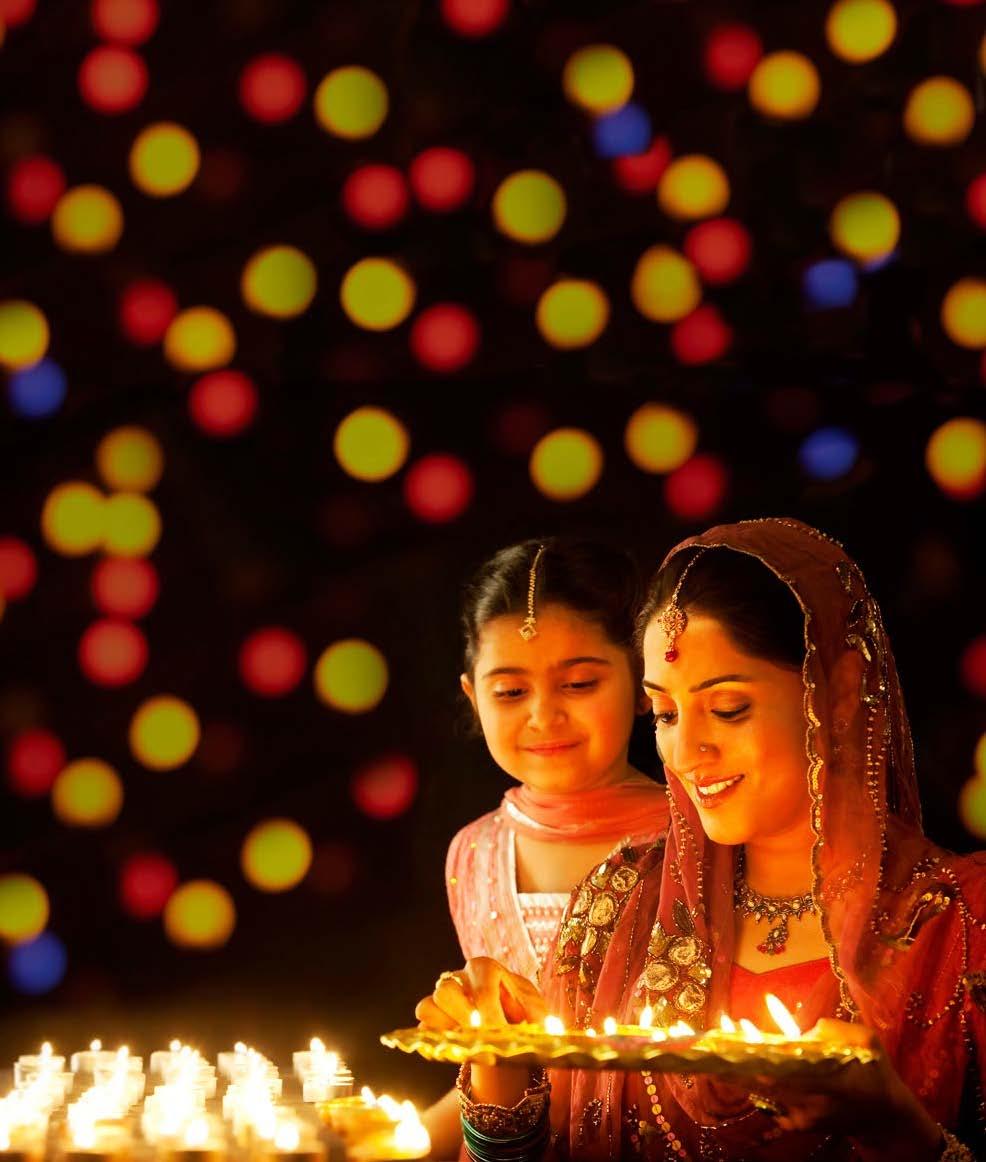




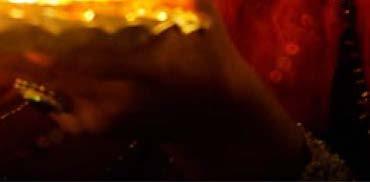


































SEPTEMBER 2020 39 NATIONAL EDITION Entries open 6 Oct to 6 Nov Cash prizes to be won! India Link Advert - Diwali Light Comp 2019-250x358mm h-DARK BOTTOM-Ver1.indd 1 8/9/20 1:32 pm
Perfect Synergy
This four bedroom, deluxe double storey home combines all the best features we’re famous for, all under the one roof.




The kitchen takes centre stage with an oversized island bench, European appliances and a huge butler’s pantry^. The impressive open-plan living and dining is surrounded by huge glass doors that let in natural light, spilling onto an expansive alfresco. Upstairs, the living area and bedrooms are generously appointed, with a master suite that resembles an up-market resort.
•

40 SEPTEMBER 2020 www.indianlink.com.au SYNERGY 32 TIMELESS FACADE
over 80 luxury upgrades included
Ultimate Inclusions*
2700mm
Enjoy
with our
•
raised ceiling height
Luxury Smeg
• Fully ducted air conditioning •
appliances
Porcelain tiles,
flooring to living, dining, kitchen; carpets to remainder
• 40mm stone kitchen bench tops •
bamboo timber or laminate
And much,
more… *Conditions apply. ^Upgrade from walk-in pantry
much
becauseeveryone deserves a little luxury 1300 44 66 37 masterton.com.au Contact our New Home Sales Consultant Priyanka Thakur 02 9821 9780 0406 414 730 priyanka.thakur@masterton.com.au ON DISPLAY HomeWorld Warnervale

















































































































 BY RHEA NATH
BY RHEA NATH



















 BY EKAAGRA KESARWANI
BY EKAAGRA KESARWANI











































































 BY SANDIP HOR
BY SANDIP HOR

























































 BY LP AYER
BY LP AYER












































